ORIGINAL RESEARCH article
Community empowerment under powerful government: a sustainable tourism development path for cultural heritage sites.

- 1 School of Business Administration, Guizhou University of Finance and Economics, Guiyang, China
- 2 School of Management, China West Normal University, Nanchong, China
- 3 School of Management Science and Engineering, Nanjing University of Information Science and Technology, Nanjing, China
Community participation is the core of sustainable tourism development; however, it encounters obstacles at government-controlled heritage sites in China. This paper examines the status quo of community participation and residents’ empowerment perception through 25 in-depth interviews and 168 questionnaires in the Miao ethnic heritage site of Xijiang Village in southwest China, the findings reveal that: (a) The phenomenon of disempowerment focuses on the political and economic aspects, rather than the social and psychological aspects; (b) Spatial difference affects empowerment perception; and (c) Residents desire more political and education empowerment. On this basis, the present research puts forward a comprehensive empowerment system consists of system, information, and education empowerment which contributes to the theorization of community empowerment between Chinese and Western scholars and provides an alternative path to sustainable tourism development for developing countries’ cultural heritage sites.

Introduction
Community participation is the key issue for tourism development of heritage sites and is a process that is vital to enhance long-term sustainable heritage management ( Landorf, 2009 ). The participation of local residents in heritage sites improves residents’ sense of belonging, facilitates the development of social networks, makes a positive contribution to the quality of life of local residents and makes heritage site conservation programs more sustainable ( Gursoy et al., 2002 ; Nicholas et al., 2009 ; Sirisrisak, 2009 ; Rasoolimanesh et al., 2017 ). Especially after the approval of the United Nations Educational, Scientific and Cultural Organization (UNESCO) recommendation on the world heritage convention, community participation is recognized as a fundamental tool in heritage management practices, which may enhance the quality of life and well-being of communities concerned ( UNESCO, 2019 ). While community empowerment is the premise and guarantee of community participation. Without empowerment, community participation loses its support and significance ( Tang and Wang, 2017 ).
Solomon (1976) marked the formal birth of the practice of empowerment in social work. Since then, “empowerment” has been introduced into sociology, communication, and pedagogy, among other fields. Western researchers consider “empowerment” to be a process of “eliminating the sense of powerlessness” ( Zimmerman, 1990 ). Empowerment were firstly introduced as planning concepts in tourism research, and have been considered as important methods to achieve sustainable tourism development ever since. The use of empowerment in tourism research has basically followed the definition of empowerment in sociology and repeatedly argument ( Joo et al., 2019 ). Rappaport (1985) proposes three levels of empowerment in tourism communities: personal, organizational, and community-level. Wallace and Pierce (1996) further demonstrate the implementation of information empowerment and education empowerment. After that, a four-dimension empowerment framework—including political, economic, psychological, and social empowerment was proposed ( Scheyvens, 1999 ) and became the foundation for further studies ( Nassani et al., 2019 ; Abou-Shouk et al., 2021 ).
In recent years, most scholars have begun to pay attention to the specific issues of community tourism empowerment: the empowerment of vulnerable groups of women in the community ( Movono and Dahles, 2017 ; Nassani et al., 2019 ; Vujko et al., 2019 ; Abou-Shouk et al., 2021 ); the specific path of community empowerment, such as information empowerment ( Cole, 2006 ), economic empowerment ( Rayviscic and Cantoni, 2015 ; Boley et al., 2018 ) and the study of community empowerment, residents’ attitudes toward tourism development, and the effects of community tourism empowerment ( Boley et al., 2014 ). For example, Akama (1996) clearly states that to achieve sustainable development of ecotourism in Kenya, it is necessary to empower community residents and the application of the dimensions of empowerment of local tourism stakeholders provides the grounds for the participation of local tourism stakeholders in the process of sustainable development of tourism ( Naser and Saeideh, 2020 ). Khalid et al. (2019) implied that high community empowerment enables the community to establish successful sustainable tourism development through local people’s support for tourism and do affect the sustainability of rural tourism development by participate in decision making, empowerment, and community knowledge about tourism and has being a way to develop the sustainable tourism village in an emerging country ( Fong and Lo, 2015 ; Purnomo et al., 2020 ).
However, community participation faces a variety of challenges in China, such as focus on economic interests, residents’ passive and ineffective participation, and the distribution of tourism profits and gains unfairly ( Zuo, 2009 ; Guo, 2010 ; Zuo and Bao, 2012 ). These phenomenons exist not only in China but also in Zimbabwe and other developing countries ( Yanes et al., 2019 ; Li et al., 2020 ; Gohori and Van, 2021 ). So Chinese scholars have identified a gap between western theories and their implementation in Chinese society though conducting research on disempowerment and the perception of empowerment in tourism communities ( Zuo and Bao, 2008 ; Weng and Peng, 2010 ; Hu and Lei, 2014 ; Wang, 2018a ). The reasons for the failure of community participation in Chinese tourism development are “the failure of rights, the lack of opportunities and ability,” and the primary cause is that the theory of community participation does not answer the question of “why to participate” from the political view; the question of “how to participate” and “being able to participate” are fully ineffective ( Zuo and Bao, 2012 ).
Although the practice of community tourism empowerment in China has encountered many problems, it has still achieved positive impact on community participation and justice perception and promote the economic growth of heritage sites, which varies from the different management models and the state-owned private heritage management model has the highest performance ( Ma, 2015 ; He et al., 2019 ). In China, heritage sites are divided into three types according to various stakeholders in China: government-controlled sites, community-autonomous sites, and franchised sites ( Hu and Lei, 2014 ). The Table 1 described the definitions, characteristics, and representatives sites of the three management types.
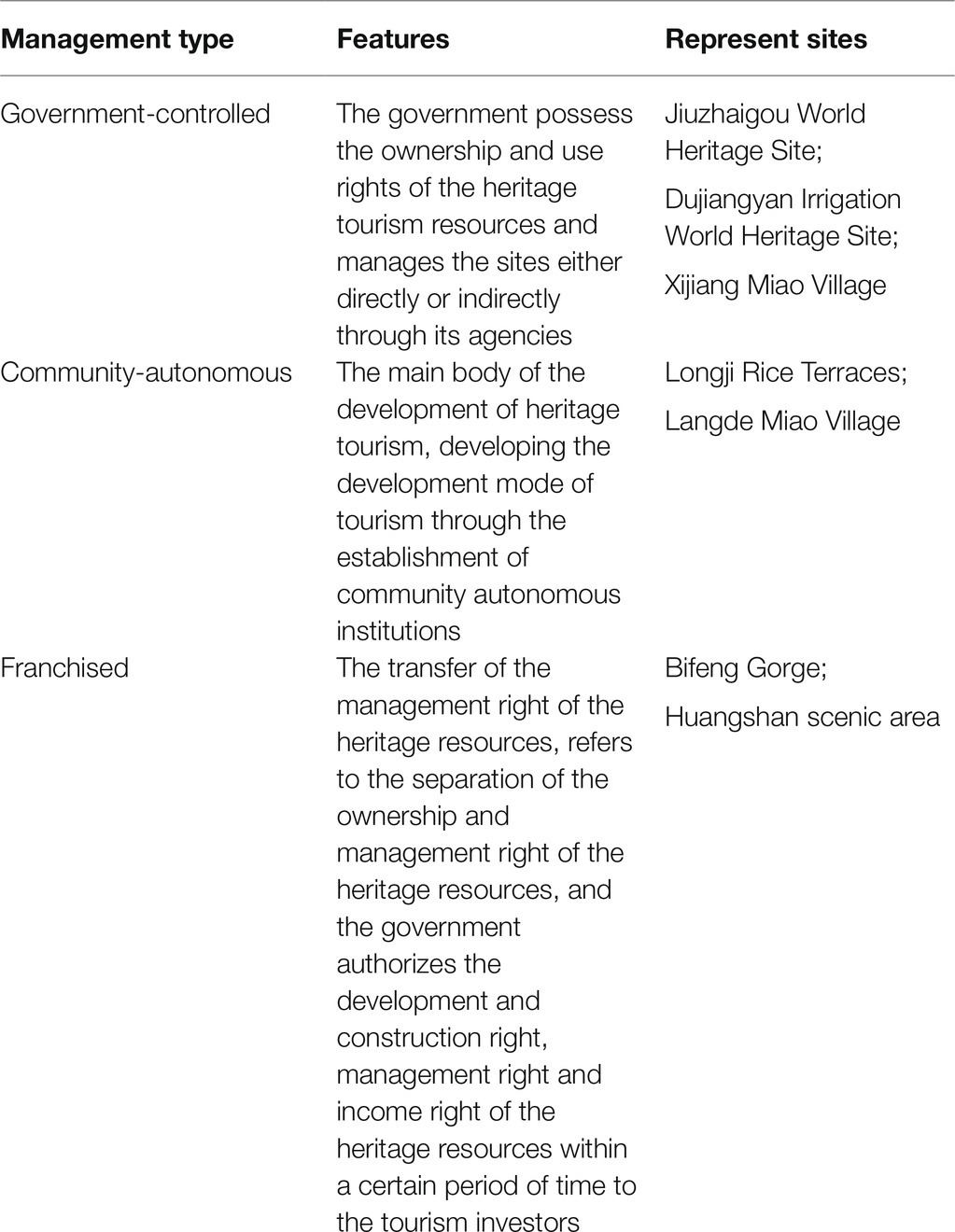
Table 1 . The table of the three management types of sites.
The previous studies have innovated ways to achieve empowerment in tourism communities and paid special attention to system empowerment ( Guo, 2010 ; Wang, 2012 , 2018b ; Chen et al., 2017 ). Most studies either propose a rough idea of empowerment from a micro-resident perspective or they define empowerment only from a macro-policy perspective, lacking micro-demand analysis, and measures of implementation. And few research analyzes its tourism community participation from the perspective of heritage management system, let alone focus on the powerful government place like China.
Therefore, the author believes that empowerment in tourism communities is a systematic project, which cannot be accomplished through a single method. It requires multilevel paths to achieve sustainable development of tourism empowerment. In order to effectively realize community participation, community empowerment must be carried out, especially, in western minority areas of China which are facing the reality of backward economic foundation, imperfect legal system, lack of democratic consciousness, and low quality of residents. The present research examines the status quo of community participation and explores the challenges and difficulties community empowerment has met in a government-controlled heritage site, Xijiang Miao Village, through the lens of both local and global tourism empowerment literature, as also as digs the reasons behind these obstacles deeply. With that, a reasonable and effective mechanism has been constructed to solve these problems in government-controlled heritage sites which is suit the Chinese situation.
We hope to contribute to the literature on tourism community empowerment for government-controlled heritage sites in the following ways. First, our research reaffirms the significance of western empowerment theory, while suggesting a comprehensive framework based on the features of Chinese society, which helps to enrich the theoretical system of tourism community empowerment. At the same time, We puts forward a comprehensive empowerment system consists of system, information, and education empowerment, which contributes to the theorization of community empowerment between Chinese and Western scholars and provides an alternative path to sustainable tourism development for developing countries’ cultural heritage sites. Last but not least, based on the case of Xijiang, we not only put forward a specific path for the community tourism empowerment in Xijiang Miao Village, but also provide a choice way to develop tourism in similar tourism heritage sites.
Theoretical Framework
In the West, community empowerment theory is a result of the democratic political, economic, and cultural system, which advocates human rights, private property ownership, and stakeholder theory. However, the concept was amended in China due to the public land ownership system, weak democratic awareness and participation, and the lack of Non-Governmental Organizations (NGOs; Sofield, 2003 ; Zuo and Bao, 2012 ). It is different from Western theory in three aspects. Based on the three differences of Chinese and Western community empowerment theory, this paper builds a community empowerment framework under the circumstance of Chinese society ( Figure 1 ) to further improve the theory of community empowerment in the Chinese situation, and become the theoretical framework of this paper.
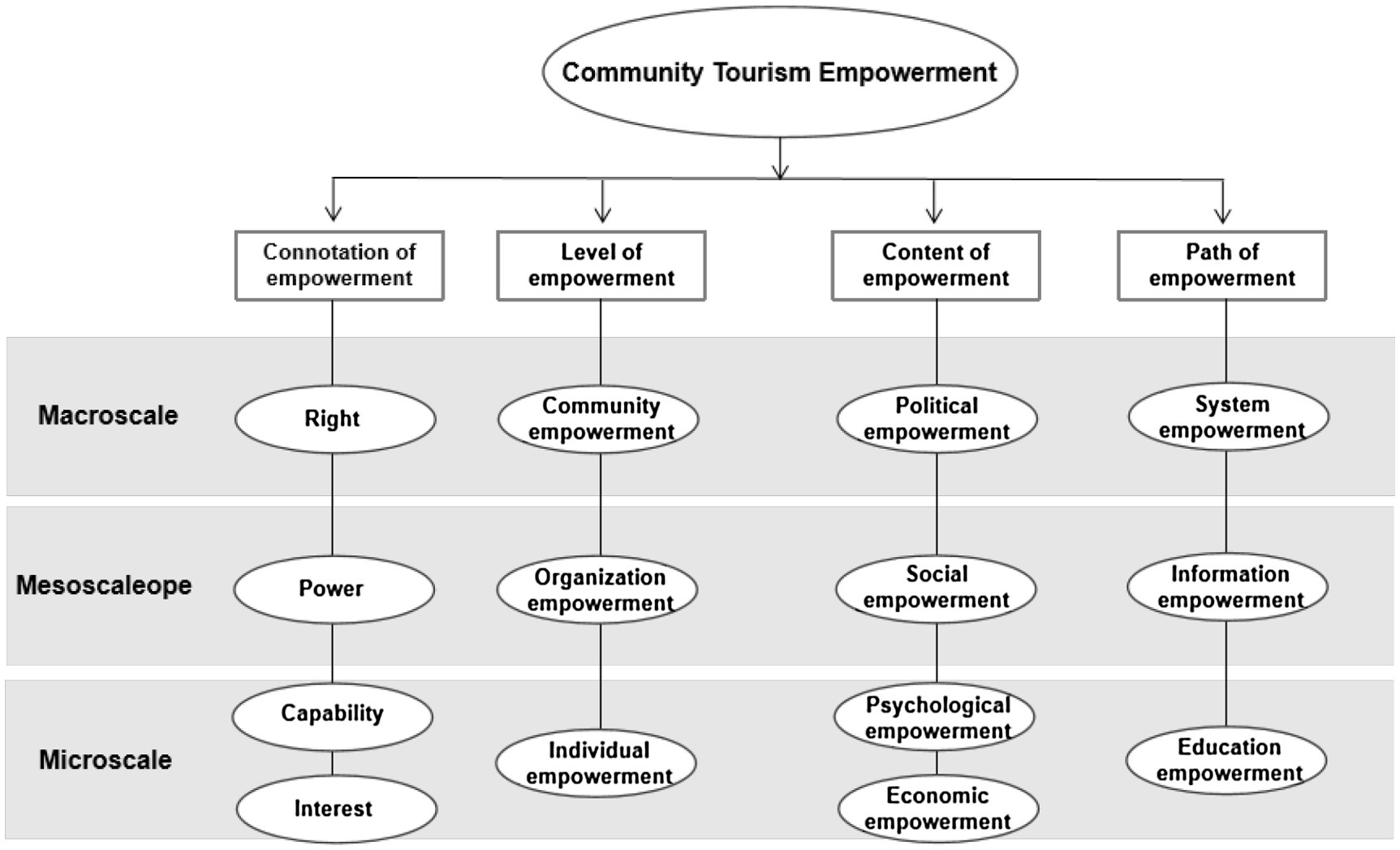
Figure 1 . Theoretical framework of community empowerment in China.
Firstly, the connotation of community empowerment differs. The western community tourism empowerment theory limits “empowerment “to “power” and “capability,” advocates the promotion of “power and capability” of community residents to participate in tourism through community empowerment, and defines this “power” as the improvement of “power” and “capability” of community residents ( Sofield, 2003 ). Western theory provides measurements for residents to participate in community affairs ( Weng and Peng, 2014 ), but it does little to answer the fundamental question of “Why should they participate?” The authors believe that to fully exert community participation, residents should be given rights at the macro law-making level, power at the meso-administration level, and individual capability, as well as the protection of the “interests” of community residents (the first column of Figure 1 ). Right is the concept of law, is the right to safeguard interests, such as human rights, property rights; while power is a political concept, which refers to the coercive power entitled to control others, such as the power of state and position.
Secondly, the object of empowerment is different. Western theory views individuals as participants in social organizations, fighting for personal right as the main method of community empowerment ( Zimmerman, 1990 ). However, Chinese society prioritizes collective rights and interests over personal ones due to its philosophic belief in harmony between heaven and man. Therefore, individual empowerment cannot be realized if organizational and communal rights and interests are not achieved. Under this circumstance, the community becomes the representative of its residents. Only when the entire community gains legal competency can each individual participate in tourism and gain profit from it. So this theoretical framework proposes three levels of empowerment in tourism communities: personal, organizational, and community-level (column 2 of Figure 1 ) which is same to the Rappaport (1985) , but in the Chinese context, more emphasis is placed on the systematization and top-down of the three, rather than just on a certain level.
Finally, there are various paths to realize community empowerment. Western scholars emphasize educational and informational empowerment ( Wallace and Pierce, 1996 ), which is associated with private land ownership and democracy. Economic reform must be guaranteed by a political system which failure to ensure in Chinese community’s public interests ( Boley and McGehee, 2014 ). In China, where social transition is still in flux, a top-down system of empowerment must be built; that is, the government needs to legitimatize community empowerment both legally and politically. Therefore, it is necessary to bring the system empowerment into the implementation path, and form a path system of the system empowerment, information empowerment, and education empowerment (column 4 of Figure 1 ), which is discussed in detail in the fifth part of the article.
It can be seen based on the above discussion: (1) Formulating right, power, capability, and interest into a four-in-one component system to differentiate the connotation of empowerment; (2) Incorporating empowerment framework of Scheyvens (1999) and empowerment levels of Rappaport (1985) , but the emphasis is different; (3) Proposing a systematic framework where system, informational and educational empowerment are the main paths; and (4) Categorizing all the above into three scales: macro-, meso-, and micro-scale.
Materials and Methods
The research area.
Xijiang Miao Village, locates in the Qiangdongnan Miao and Dong Autonomous Prefecture, Guizhou Province. The Miao, an ancient cultural group and now the fourth largest ethnic minority in China, lives primarily in the mountainous areas of Guizhou, Yunnan, Sichuan, and other provinces in the southwest. Some sub-groups of the Miao, most notably the Hmong, have migrated out of China into southeast Asia and other western countries. They have their own languages, religious beliefs, and other folks. As the largest Miao inhabited area in China, Xijiang village developed during the third migration of the Miao people and now has a history of about 2,000 years and 1,288 households with a total population of nearly 6,000 accounting for 98.5% Miao globally. It is the largest Miao majority region in the world. The entire Miao habitation was built in the mountains and along water with a magnificent view of layers of terraced buildings, the typical style of Miao architecture (see Figure 2 ). The settlement is built in a vertical structure, with four villages: Pingzhai, Dongyin, Nangui, and Yangpai. Pingzhai and Dongyin is closer to the core business district of the scenic spot compared with the others, and the village population is larger, tourism participation is more actively (see Figure 3 ).

Figure 2 . Bird’s eye-view of Xijiang Miao Village (Source: The official website of Xijiang Miao Village: http://www.xjqhmz.com/ ).
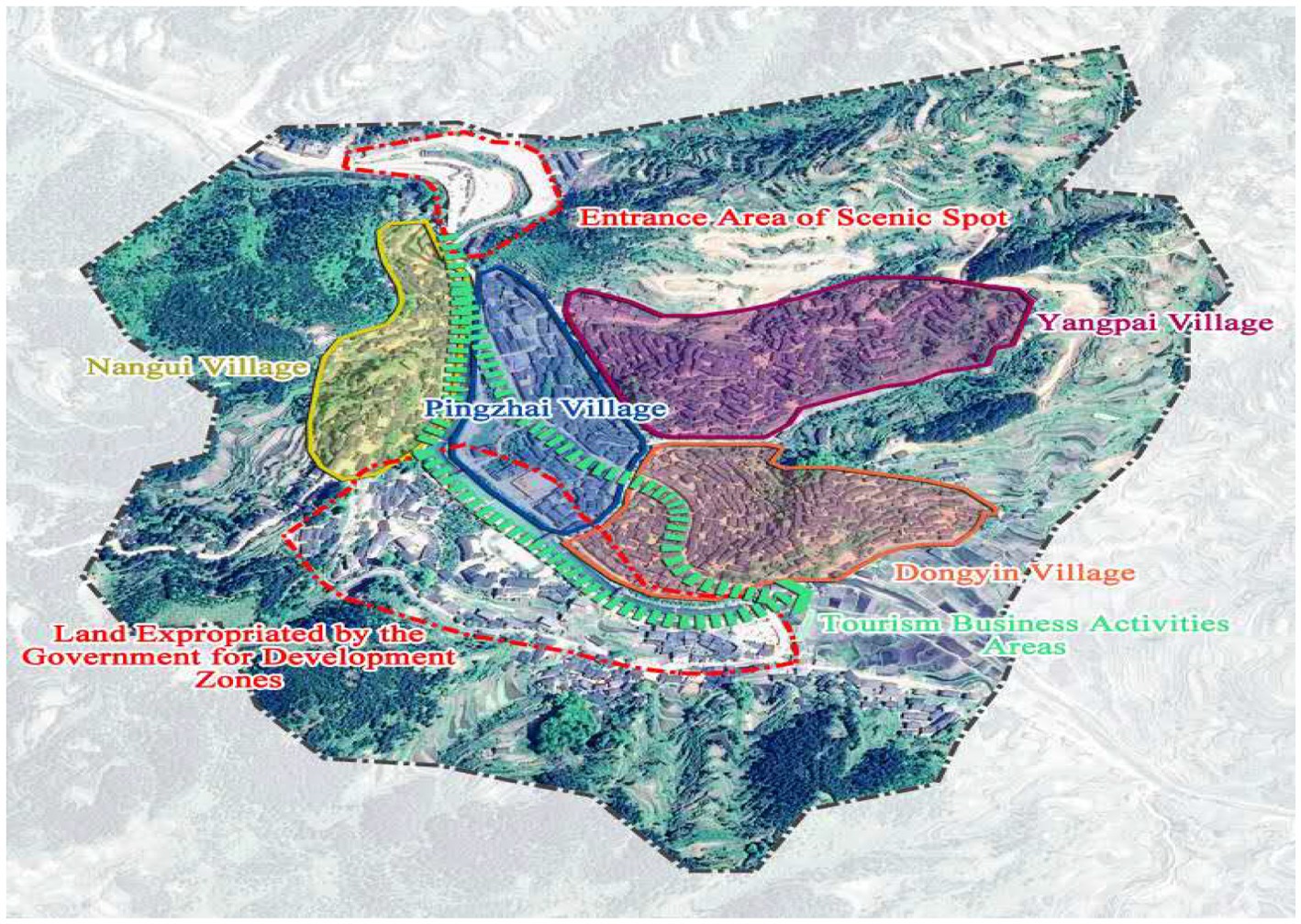
Figure 3 . Village layout topography (drawn based on Google map).
Xijiang is an essential location to learn Miao history and experience Miao culture and scenery where the Miao culture is well preserved. For example, every year in the Miao calendar New Year will hold a long table banquet, a time-honored guest reception. It is reserved for special occasions, such as weddings, a baby’s first-month celebration, and important social activities among villages. At that time, each household brings out their tables and benches to be arranged in a stream on the village street, as well as provides their own hand-cooked food freely, sometimes stretching several 100 m. To the left is the host seat, while on the right is the guest seat, the host and guest sit opposite each other and sing to the wine. The host and guest are equal, and all the guests are treated equally (see Figure 4 ). Now, Long Table Banquet has become an important experience project for tourists in the Xijiang Miao Village.
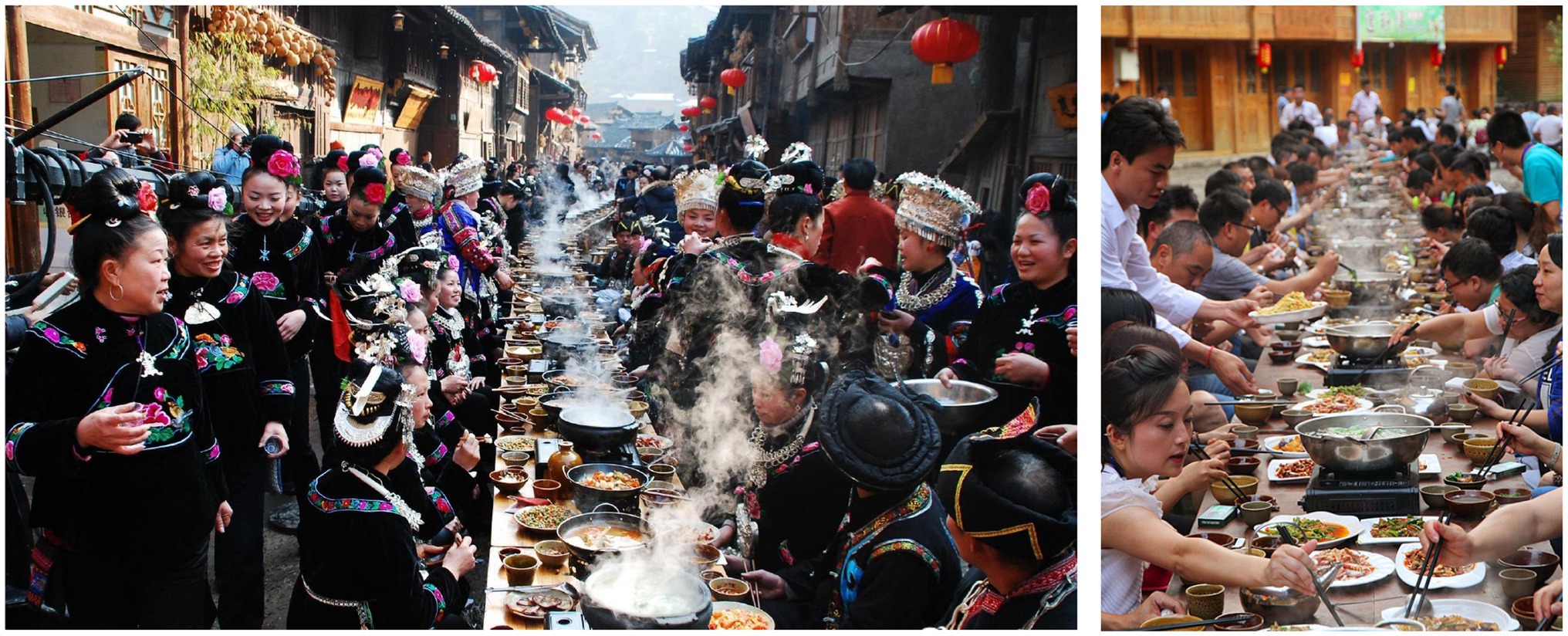
Figure 4 . Long Table Banquet for villagers ( left ) and visitors ( right ; Source: The official website of Xijiang Miao Village: http://www.xjqhmz.com/ ).
Since its inception, it has received considerable attention from the outside world. Looking from the history of tourism development in Xijiang Miao Village, it followed a typical government power intervention path. In the first stage, the village officials took the lead to develop tourism independently, while the government took over later on and formed a new pattern which comprises of the lead of government, the intervention of enterprises and community participation. In terms of operation and management, it seems to be commercialized. However, the “Scenic Authority” and “Scenery Development Company” are both established by the government. The local residents formed the defacto ownership of tourist resources by owning their dwellings and the right to use the surrounding land. However, due to the complex interests relationships, most community residents turned from support for tourism development in the early stage to complaint about its unfairness and it is getting worse.
Xijiang Miao Village, as a typical heritage tourism destination in western ethnic areas of China, has strong representativeness in the process of interest conflict and empowerment perception. How to solve the interest conflict phenomenon of heritage tourism destination under the strong power of the government and build a harmonious and stable win-win interest mechanism are the common problems to be solved in the development of heritage tourism destination in western ethnic areas of China and other developing areas.
Sample and Procedures
To reduce the impact of common method variance, the research group conducted two-stages surveys. In order to make the interview more meaningful and realistic and provide basic guidance for the compilation of the survey items, the research team went through expert consultation and group discussion before the investigation from July 23 to 30, 2017, and further optimized interview subjects to eventually form the in-depth interview topics of involvement, impact of tourism development, awareness, and capability which in the following Table 2 . At this section, the group interviewed 25 people in total using stratified sampling, including three in the Authority, six in Pingzhai, six in Dongyin, five in Nangui, and five in Yangpai ( Table 3 ). The number of interviews is determined by 2% of the permanent households in the four villages. Each household will be interviewed centrally. At the time of the interview, everyone of the family can participate, mainly with the opinions of the householder, and listen to the opinions of others. That is because the structure of most residents’ homes is three generations together, that is, the grandparents, the parents, and the children live together, and the children go to school, the grandparents take care of the family, and the parents are the main sources of family economy. The occupation of the interviewer on Table 3 is based on the identity of the interviewer, that is, even if some interviewers are engaged in a private shop owner, they will still run the farmland in their home, and their identity is still a farmer.
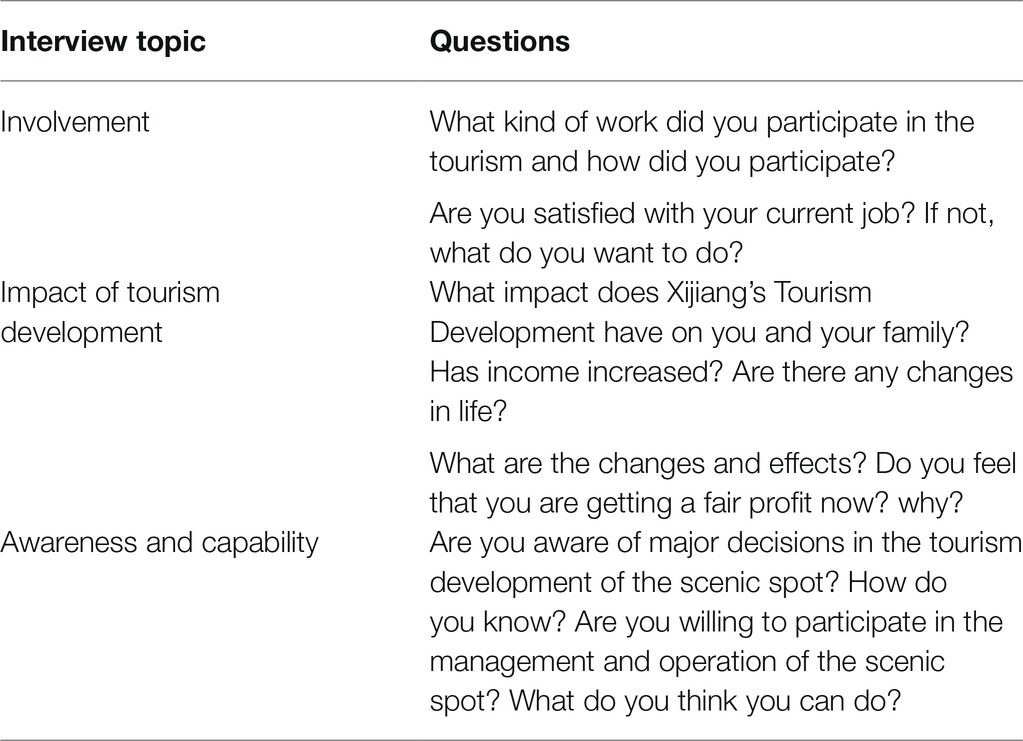
Table 2 . In-depth interview topics.
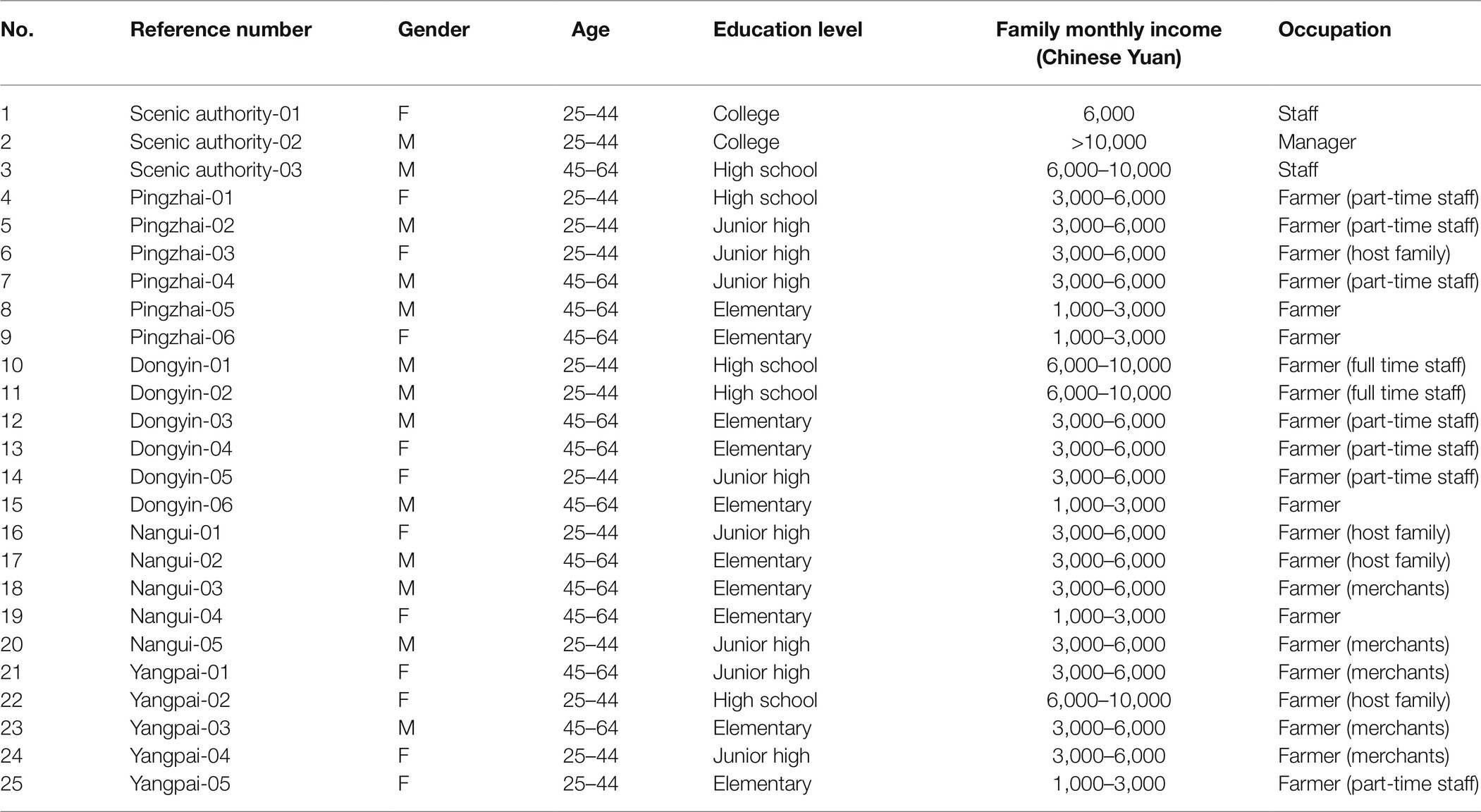
Table 3 . Basic information and reference number of interviewees.
Since our research is funded by the National Social Science Project, the survey was welcomed and facilitated by the manager of Xijiang heritage tourism company and the “Guzangtou” who has no real power but is the informal spiritual leader of the Miao village. Our survey was led and translated by the “Guzangtou” since most interviewees cannot read or speak Mandarin. We obtained their consent orally to make sure they understood the survey was purely for research purposes, would not be released to any third-party, and conducted anonymously to protect their rights and privacy.
Based on the in-depth interviews and predecessors’ research ( Chen et al., 2011 ; He, 2017 ), a questionnaire following the four-dimensional framework of Scheyvens (1999) with 15 measurement questions were retained using a five-point Likert scale after several rounds of intense group discussions ( Table 4 ). From February 10 to 17, 2018, the trained research team conducted on the spot surveys with 220 villagers in four villages with the 2% of the number of permanent residents, and 168 valid questionnaires were obtained which is conducted when the villagers’ meetings were held in each village.
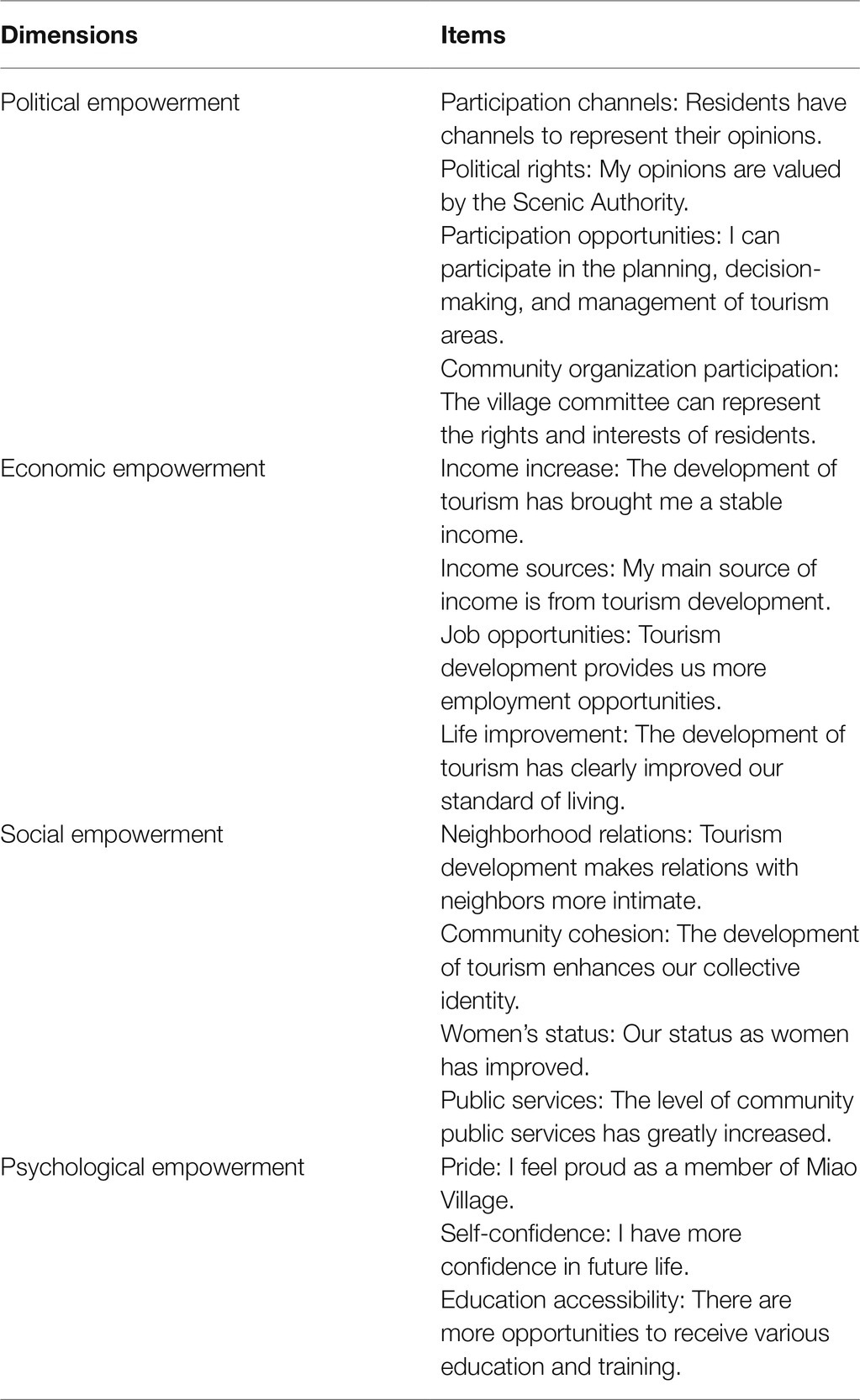
Table 4 . Measurement scale of community empowerment.
We used software SPSS 20.0 for mean and SD of the measurement items and Cronbach’s alpha indicator to test the reliability and validity of the survey. The overall Cronbach’s α coefficient was 0.8868, and the Cronbach’s α coefficients of economic, psychology, social, and political dimensions 0.8178, 0.8973, 0.9125, and 0.9198, respectively. Reliability is generally acceptable if Cronbach’s α coefficient value is greater than 0.7, high if greater than 0.9. The results of our survey are greater than 0.7 and close to 0.9 standard, indicating a high reliability.
Political Disempowerment and Empowerment Perception
With the guidance of local village leaders and cadres, residents participated in tourism independently and autonomously. Constrained by underdeveloped infrastructure, local tourism evolved fairly slowly. In 2007, local government became fully involved in its tourism development and funded planning, infrastructure construction, marketing, and personnel training. It is undeniable that local tourism developed rapidly after governmental involvement. By 2017, the number of tourists had reached 7.5 million. There are currently more than 100 Miao restaurants, 500 hotels and inns, and 160 souvenir shops in Xijiang.
Significantly, the government is the main investor, marketer, and manager at the same time in Xijiang. The tourism development company and the heritage site administration committee take charge of Xijiang’s tourism, which are set up by the government with the same staff. Therefore, the government takes care of all the issues of the development of the scenic spot and determines the development direction of the scenic spot. But the actual owners of the cultural and scenic capital of Xijiang are residents, so their ownership position has been taken away by the government.
Their development goals and rights are not fully satisfied in three main ways. First, residents lost ownership of their land due to the mandatory land transfer system. In order to expand the commercial space within the heritage site, the management company, in the name of government, forced the requisition of several acres of fertile land along the Baishui River (the main river channel in Xijiang), and they converted it into commercial buildings for rental and tax purposes ( Figure 3 ). High profits were made through this process, but residents received only a modest one-time land compensation.
Second, residents have little access to information and few rights to express themselves. During the development, all information related to planning, construction, financing, and personnel are completely closed to the community. Even income distribution is formulated by the government without notice. Finally, residents’ right to education is not well-protected either. Training and education are important guarantees for the development rights of community residents; however, survey statistics show that 60% of interviewees only have primary and secondary education and that 80% of villagers do not directly participate in tourism management or service work. As the residents say:
“Can we have any opinions on the scenic spot? Even if we do, who can we report to and who will listen to us?”—(Pingzhai-05).
“Let the local people participate in the management of our scenic area? Why should they be involved? Do they understand heritage protection? Do they understand how to promote the scenic area?”—(Admin-02).
These statements coincide with arguments of Scheyvens (1999) which pointed out that political disempowerment exists, where the management agency is a tyrannical, self-interest-oriented leadership organization. They believe it is because of their active charity that community residents benefits from tourism development. Community members feel that they have little or no opportunity and power to express relevant opinions, and that they are not allowed to participate in the decisions of tourism development.
The research on the perception of political empowerment further confirms this problem, which results show that community organization participation contributes the most to political empowerment perception, while limited opportunity to participate in decision-making is the biggest obstacle for empowerment in all four villages ( Table 5 ). In general, Nangui and Yangpai have higher political perception than the other two villages that are closer to the main tourist area. It seems surprising that the more active residents are in tourism-based economic practices, the lower their perception of political empowerment is.
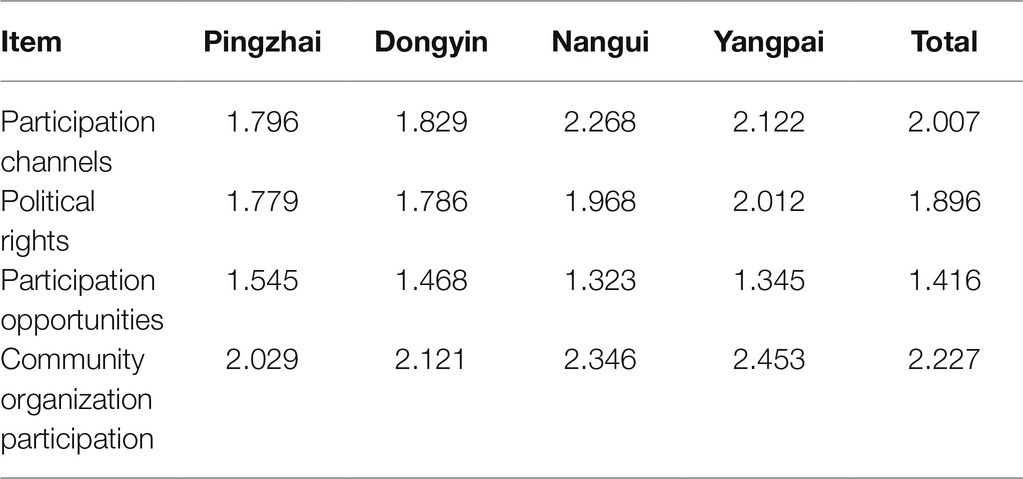
Table 5 . Means analysis of political empowerment perception.
Based on a comprehensive analysis of interview and survey results, the study found that the more residents are dependent on the tourism economy and exposed to the outside world, the more they know about their rights and thus have more conflicts with the government. On the contrary, the less participation and access to information, the less the conflicts with the government. Ironically, this situation makes them believe that they have higher political empowerment.
Economic Disempowerment and Empowerment Perception
Xijiang residents profited more following the increase in tourism. There are mainly four ways to make money: (1) Independent investment and operation: residents use their own property to run ethnic restaurants, inns, stores, etc.; (2) Rental: most residents rent their property to tourists for accommodation due to a lack of funds and skills to produce other revenue; (3) Selling local products and ethnic handicrafts such as Miao medicine, embroidery, silverware, etc.; and (4) Participating in labor-intensive services, such as song and dance performances, cleaning, car battery transportation, etc.
However, conflicts appear gradually accompanied by the distribution of interests. As the government is not an “economic entity” in a complete sense, it needs financial support to achieve some of its political goals. Hence, it is inevitable that the government fights with community residents for economic resources.
For example, the government claimed that it stipulated the cost of infrastructure construction and marketing expenses for the development of scenic spot, so most of the ticket income (90%) is obtained by the scenic spot management company on behalf of the government, while only 10% of the profit went to the residents in the form of a completed heritage preservation project. What is more serious is that residents have very little agency in the way of income distribution, which will certainly arouse the dissatisfaction of the community residents. Just like the residents say:
“We do have better income and better living standard than before. We receive thousands of RMB Yuans each year from the government, but most of the money is earned by the outside business owners. My family only collects some rent every year.”—(Dong Yin-04).
“Yes, we can make more money than just working in the farm in the past. But our family is on the mountain, the business is only good on holidays and during July and August. We can make more money during these times but the business is much worse at other times. The outside business owners are not willing to rent our house.”—(Yangpai-03).
Local residents gain continuous economic benefits from tourism industry and their living standards are significantly improved. But they have obtained only a small amount of unstable income while community elites, foreign tourism developers, and local governments have obtained most of the benefits. This phenomenon is the economic disempowerment described by Scheyvens (1999) .
Even with the internal and external conflicts of interests, most respondents agree that tourism development in Xijiang has brought real benefits to the local community, such as increased income, more job opportunities, and better standards of living ( Table 6 ).

Table 6 . Means analysis of economic empowerment perception.
A phenomenon worthy of attention is that compared to Pingzhai and Dongyin Villages which are closer to the core tourism area, Nangui Village and Yangpai Village have relatively lower perceptions of economic empowerment. But Pingzhai and Dongyin benefit more due to their advantageous location. In this case, spatial differences influence residents’ perception of economic empowerment, but behind the scenes, the imbalanced income distribution system is key.
Social Disempowerment and Empowerment Perception
The social empowerment in tourism is realized when tourism maintains or improves the balance of the local community; when individuals and families work together to build a successful tourism company and the degree of integration of the community is improved; when partial tourism proceeds are used on community development ( Scheyvens, 1999 ). Tourism development has greatly enhanced the collective sense of honor and community cohesion of Miao people in Xijiang, where the perception of community cohesion, the status of women, and the level of public services are all positive in the four villages ( Table 7 ). They spontaneously established the “Family Inn Association” and the “Xijiang Senior Citizens Association.” The development of the tourism industry combines traditional culture and interpersonal relationships in the ethnic areas and strengthens the cultural memory of the community ( Chen et al., 2013 ).

Table 7 . Means analysis of social empowerment perception.
Nevertheless, most touristic activities happen along the main street of the most scenic area in the region. Thus, the two villages in the core area, Pingzhai and Dongyin, have increased chances to receive tourists, while the other two villages, Nangui and Yangpai, have less opportunities (see Figure 3 ). For example, property rental and business are more prosperous in Pingzhai and Dongyin than in Nangui and Yangpai, while the negative economic impacts of tourism, such as rising living costs and shortages of goods and services, are equal among all villages. Increasing inequality between the poor and the rich generates tension among community residents. In the off-season, they even fight for opportunities to receive tourists; thus, relationships in the community have deteriorated. But before the tourism development, the spatial differences of villages’ location will not bring obvious economic level differences. Neighbors had closer relationships than now and many kinds of mutual help phenomenon exist, the community cohesion was strong. Just they say:
“We are old and we are female. We sweep the streets for living. Most of the time we sell things here. The money is definitely less, but we can only do this!”—(Yangpai-05).
“We have more income and better living standard than before, but the relationship between relatives and neighbors is not as good as it used to be. We used to practice Long Table Banquets in the stockades before. It was not for outsiders. It is for our a good relationship. Now everyone is money-driven and often quarreled.”—(Nangui-04).
Psychological Disempowerment and Empowerment Perception
As indicated in Table 8 , residents have a stronger perception of “pride” and “self-confidence,” which are beyond their words in the interview. As mentioned, Xijiang Miao Village has been acknowledged nationwide and residents’ sense of ethnic pride has greatly improved.

Table 8 . Means analysis of psychological perception.
“Who would have known in the past that we will engage in tourism in this place. Some of them (tourists) like our shabby houses. We must thank the government for developing tourism!”—(Pingzhai-03).
“There are more time to dance and sing, and host festivals. People outside like to watch us dance and hear us sing. We also like it.”—(Dongyin-05).
Every informant confirmed that with the increase of family income and the improvement of living standards, residents’ self-confidence in the future was strengthened. According to Scheyvens (1999) , psychological empowerment is established when foreign tourists consider the local culture, natural resources, or traditional knowledge to be valuable and unique, which in turn increases the pride and self-esteem of local residents because they feeling that community is concerned and there are special things to share with outsiders. The increasing confidence encourages them to receive further education and training. Based on this opinion, Table 8 gives us a warning: compared to their perception of “pride” and “self-confidence,” their perception of “opportunity for education” is weaker, which reflects the urgency of increasing education empowerment in ethnic minority areas.
They actively seek various education and training programs to increase employment opportunities. In the process of tourism development, local women gained more income from tourism development than traditional agriculture and demonstrated their capabilities by participating in singing or dancing performances. Thus, their family status has also been improved.
Conclusion and Discussion
Research conclusion.
From the above analysis, Xijiang Miao Village, as a typical government-controlled ethnic heritage site in western China, manifests the features of compulsory government-led tourism development. The results for field research demonstrated that: (1) The disempowerment phenomenon concentrate on the political and economic aspects not on social and psychological aspects. Most interviewees showed great respect of local culture and satisfaction of their job arrangements in the administration bureau, and they has shared the economic benefits and improved living standards through tourism development, but complaints about imbalanced interests distribution still exist and the lack of political participation has become the biggest obstacle to the empowerment of residents’ communities. (2) Spatial difference affects the degree of participation and further influence empowerment perception. Pingzhai and Dongyin Villages, which are closer to the main street and have more opportunities to participate in the tourism development, have a lower perception of political empowerment, while have higher economical, social, and psychological empowerment perception, but it does not work in the villages of Nangui and Yangpai. (3) Residents desire more political and education empowerment. Residents’ weaker perception of political empowerment reflects the potential growth and necessity of political empowerment in government-controlled heritage sites like Xijiang Miao Village. This shows a stronger desire for political empowerment in villages that are more economically active, while education empowerment is the fundamental way to achieve it.
Such research conclusions have been drawn in other similar settings, Abou-Shouk et al. (2021) with partial least squares structural equation modelling (PLS-SEM) employed to analyze the perceptions of 784 respondents across the three countries and the findings reveal that significantly different effects of women’s empowerment on tourism development and must not ignore socio-cultural facets of empowerment ( Aghazamani et al., 2020 ), Thanks to being given information and knowledge through empowerment, the villagers set up confidence and responsibilities to participate, which has changed their cognition of, emotion for and interaction with community planning, development and themselves ( Xu et al., 2019 ). At the same time, Ostrom and colleagues consider non-binding communication can serve as an effective mechanism for solving social dilemma problems in common-pool resource settings ( Ostrom, 2008 ; Ahn et al., 2010 ).
Studies and practices have proved the importance of taking residents’ will and interest into consideration during tourism development in ethnic areas ( Wang, 2006 ). The current system has disempowered community residents to a certain extent, thus as described in the theoretical framework in Figure 1 , the evolution from a compulsory top-down system to an inductive bottom-up one, which emphasizes the leading position of local residents and unanimous recognition and participation, is necessary. In all, community residents need a comprehensive empowerment system to secure their rights and interests.
Xijiang Miao Village demonstrates the common phenomenon that many ethnic heritage sites in western China face. With the development of tourism, the economic, social, and psychological empowerment of community residents has been realized partly, but this kind of government-led top-down mandatory supply system of tourism empowerment has not fundamentally solved the contradictions in the process of community tourism development in ethnic areas. From the case of tourism empowerment in the Xijiang Miao village, we have found a path to from the contents to achieve “empowerment” in the community, that is, to achieve political empowerment from institutional empowerment and to achieve autonomous empowerment through education empowerment and information empowerment.
System Empowerment Is the Fundamental Guarantee of Community Benefits
In recent years, Chinese scholars have also explored the reasons for the failure of community participation in China from the perspective of laws and regulations, and they have proposed a basic path for system empowerment. It is apparent that current laws and regulations fail to ensure the right to community participation and cannot define, regulated or protect it ( Wang, 2012 ; Wang and Zheng, 2015 ). However, real community empowerment requires the long-term support and authorization of the government which is the Chinese scholars hope to set up ( Peng, 2010 ; Weng and Peng, 2014 ; Wang and Zheng, 2015 ). Based on the field survey and forefather’s research, the authors suggest developing system empowerment from the following three aspects.
First of all, land ownership reform is the foundation of system empowerment. In recent years, the survival and livelihood of farmers who have lost land due to tourism development have been a matter of common concern for the Chinese government. Some experts and scholars advocate returning land ownership to farmers; that is, privatizing the land ( Wu, 2009 ). However, most scholars believe that Chinese farmers need stable land and contractual land management rights rather than land ownership ( Chen et al., 2013 ). In fact, due to the strong power of local government and collectivism, land privatization may bring about huge institutional costs, out-of-control land sales, and other issues related to rural stability ( The office of the CPC Central Committee and the Office of the State Council, 2014 ). In 2014, the publication of No. 71 (Document of the Bureau of National Development) formally separated land ownership, contracting rights, and management rights in rural China which identified the direction for the reform of land ownership in heritage sites. Land management rights refers to the fact that residents have legal operation and management rights to land sale, lease, mortgage, transfer and other activities, and these rights can be legally guaranteed ( Zhao, 2008 ). In order to return the right of permanent management of land to farmers, first of all, we must ensure that the right of management become a real “property right.” Secondly, we must establish a unite, open, competitive, and orderly market for land management rights to guarantee the transfer is in order. Only when the land management right becomes a real property right, can community residents have the right to dispose their own land and management rights, as well as protect the resources related to the land. This is way, we can build institutional protection barriers for community residents in the process of tourism development.
What is more, property laws governing tourist attraction should be promulgated. Research has found that there were two basic interest conflicts between community residents, governments, and outside developers: under-compensated land price and deliberately neglected compensation of future gain of assets during the land transfer process ( Sofield, 2003 ). In Xijiang Miao Village, the residential building, living environment (such as lakes, mountains and forests, and animal and plant resources, historical sites, etc.) and folk customs of the local community have become the core tourist attractions, although local governments and their development companies have invested in the development of tourism (such as parking lots, plazas, roads, etc.), it is not the result of these inputs that really attract tourists, but the original Miao culture and landscape. The landscape, culture, and customs are all in line with the constructivist authentic culture and retain the traditional living customs and cultural art of the Miao nationality. Yet, local residents, the actual owners of these tourist attractions, were left out from financial gain. Therefore, it is urgent to stipulate provisions on intangible rights in property law. Only in this way can we protect community residents’ rights and provide them a leading role to participate in tourism development.
Last but not least, a mutual benefit mechanism between local residents and developers should be established in any land management system. In the existing way of tourism development, land is often purchased or rent by outside investors at one time to obtain more long-term profits. It is neither fair nor sustainable for developers to benefit the most while residents receive only limited rent from land-leasing. The biggest dissatisfaction among the community residents where we surveyed is the profit imbalance. It is not poverty but inequality that caused sharp conflicts in community tourism development.
Thus, instead of renting or transferring their land, community residents should invest their land in the tourism industry for future gains which the innovative forms of land transfer are also the guidance of government. The use of land shares is a new and effective, yet rarely adopted, method to resolve conflicts of interest in land transfer which allows residents to lease their land to enterprises and also to invest their property—with tourist attractions attached to that land—into the share capital of the enterprises.
In that case, community residents can obtain stable income as well as dividends from the development of the heritage site according to the number of shares converted from tourist attractions. Besides, as a shareholder of the tourism enterprise, community residents can also exercise real rights to participate in tourism development, such as planning, decision-making, and management of tourism areas.
Information Empowerment Makes Community Participation Mechanism More Transparent
Information is the key to navigating decision-making among various stakeholders. Information asymmetry is the leading cause of the tragedy of the commons. Under the influence of a planned economy, with its policies and bureaucracy, local governments avoid informing local residents of their decisions in case any unpredictable incidents will jeopardize upcoming investments. Although China has achieved rapid development during economic transition, democratization, and civil rights awareness have not yet reached the same level.
The lack of a communication platform and mechanism puts residents in a vulnerable position. In order to change that, the government should first recognize residents as the main body of tourism development and increase their self-awareness. It is the government’s responsibility to initiate effective communication and truly benefit local people instead of taking advantage of them. Next, the government needs to set up a long-term mechanism for information disclosure on tourism development which specifies the time, periodicity, and content of information to be released. Finally, a platform for information exchange and communication should be built; for example, the village committee or tourism professional associations could act as liaisons so that information related to tourism development can be delivered to each community inhabitant.
Education Empowerment Fosters the Ability of Community Participation
In the survey data from Xijiang Miao Village, family income and community tourism participation are positively related to education level. Households that have received junior high school education and above have a higher family income and more members participating in community tourism than those who only have junior high degrees or below. It is helpful for residents to obtain more information, but this requires residents do have awareness of their rights and the ability to fight for them. Thus, education empowerment is extremely important to realize that.
Education empowerment includes three components. At first, community residents must improve their legal awareness to understand national policies on land expropriation, resources protection, and traditional culture protection. Then, modern tourists have an ever-increasing higher demand of quality from tourism professionals, which stimulate the community residents to improve their operating abilities, management abilities, and service skills. In Western developed countries, third-party civic organizations take charge of the educational and training functions for most community residents. However, in China, these organizations develop relatively slowly and lack the necessary financial support due to constraints of the social system. Therefore, it is the governments’ responsibility and obligation to provide education and professional skill training. Local governments should allocate a proportion from tourist gains to provide education and training or establish a special training fund for this purpose.
In the end, abundant cultural practices in heritage sites in western China have become important tourist attractions, such as folk songs and dances, arts, and crafts. Local governments should also allocate special funds to educate and train residents to maintain craftsmanship in the intangible cultural heritage of these peoples, such as certifying inheritors of non-material cultural heritage and providing training on cultural heritage inheritance education, especially to the younger generation so that they find confidence and recognition from their own culture. Additionally, local governments in ethnic regions should strengthen cooperation with tourism colleges and research institutions. In that case, colleges and research institutions find research places, and the voluntary lectures of experts and students’ internships in the community can greatly improve the residents’ awareness of their rights and ability to participate in local tourism development.
Research Gaps and Outlook
This work measures the residents’ empowerment of power in social, political, and other aspects from the perspective of psychological perception. However, the means and methods of measurement have certain limitations, which cannot relieve the influence of cultural traditions and individual differences, and the source of analysis and conclusions of the Chinese political framework will inevitably lack rigor.
In the course of the study, we also found that the degree of tourism participation is different from the occupations of residents, and then the perception of residents’ empowerment varies. In the future, we can further study the differences in the perception of empowerment and government satisfaction in different professions.
Obviously, it is not possible for community residents alone to realize true empowerment in government-controlled heritage sites. So combine the research results and previous studies, this paper forms a comprehensive empowerment system consists of system, information, and education empowerment. The core components of system empowerment are reform of collective land ownership, the land leasing system, and property rights law. Additionally, we need to establish a mechanism and platform for residents to express themselves, discuss tourism related affairs, exchange information, and access policy announcements. Education empowerment is equally important which improve their capability to become fully engaged in tourism.
This research reaffirms the significance of western empowerment theory, while suggesting alterations should be made based on the features of Chinese society. The implication from the Xijiang case is thus meaningful and can be replicated at many other government-controlled heritage sites.
Data Availability Statement
The original contributions presented in the study are included in the article/supplementary material, further inquiries can be directed to the corresponding author.
Ethics Statement
The studies involving human participants were reviewed and approved by the Academic Committee of Guizhou University of Finance and Economics. Written informed consent to participate in this study was provided by the participants’ legal guardian/next of kin. Written informed consent was obtained from the individual(s) for the publication of any identifiable images or data included in this article.
Author Contributions
BH conceived the research and wrote the original draft. FH participated in the revision of the manuscript. LH collated the data. All authors contributed to the article and approved the submitted version.
This research was funded by China National Social Science Fund Project (17BMZ130) and Graduate Project of Guizhou University of Finance and Economics (2020ZXSY24).
Conflict of Interest
The authors declare that the research was conducted in the absence of any commercial or financial relationships that could be construed as a potential conflict of interest.
Publisher’s Note
All claims expressed in this article are solely those of the authors and do not necessarily represent those of their affiliated organizations, or those of the publisher, the editors and the reviewers. Any product that may be evaluated in this article, or claim that may be made by its manufacturer, is not guaranteed or endorsed by the publisher.
Search form
Local community empowerment for sustainable tourism development: a case study of edelweiss park wonokitri village.
© 2023 IIETA. This article is published by IIETA and is licensed under the CC BY 4.0 license ( http://creativecommons.org/licenses/by/4.0/ ).
OPEN ACCESS
Prior studies in sustainable tourism development have acknowledged gaps in our understanding of its various aspects—including environmental, social, and economic impacts—and the strategies for its effective implementation and long-term sustainability, particularly concerning the practical, step-by-step execution. This research aims to explore how empowering the local community can enhance tourist attractions, create memorable experiences, and increase visitor satisfaction, ultimately contributing to the sustainable development of the tourism village. Six informants were chosen based on their knowledge of the practice of sustainable tourism in Wonokitri village. The researchers considered six informants to be sufficient because they represent the key stakeholders involved in sustainable tourism practices that focus on local empowerment in Wonokitri village. The data was manually analyzed using a six-step data analysis process. This study's findings underscore that, beyond economic advantages, the local community garners social benefits through cultural preservation and environmental conservation, aligning with the goals of sustainable development. The collaborative efforts involving the government, private sector, and the engaged local community at Edelweiss Park exemplify how empowering the local community can foster tourism practices that yield comprehensive benefits for both the environment and the socio-economic well-being of the community.
sustainable tourism development, tourism village, local community empowerment
The development of tourism villages, as an integral part of destination tourism, has been prioritized by the Local Government. In fact, the Ministry of Tourism has established a dedicated website for tourism villages, offering them as an option for both international and domestic tourists. Out of approximately 75,000 villages in Indonesia, around 1,200 villages have been identified as having the potential to become tourism villages. The development of tourism villages is expected to accelerate sustainable tourism and foster economic growth in Indonesia, as stated by Kemenparekraf [1]. However, one of the challenges in the development of tourism village destinations is the limited research available on tourism village destination management. Research on tourism village destination management is crucial to enhance the management of these villages and provide better service quality.
Previous researchers in the field of sustainable tourism development [2-5] have recognized that our understanding of different aspects of sustainable tourism, including its environmental, social, and economic effects, as well as the strategies for effective implementation and long-term sustainability, still exhibits gaps, especially in terms of the practical step-by-step implementation. Addressing these unanswered questions and enhancing our understanding necessitates further research and investigation. This will enable us to develop more comprehensive and effective approaches for sustainable tourism development. By addressing this research gap, the study intends to offer valuable insights and effective strategies for managing tourism villages, promoting economic growth, and fostering sustainable tourism practices in Indonesia.
This study seeks to explore how empowering local communities can bolster tourist attractions, forge memorable experiences, and elevate visitor satisfaction—all ultimately contributing to the sustainable development of the tourism village.
Previous research on tourism villages development and management has explored various approaches and factors contributing to their success. For example, Adnyani and Purnamawati [6] focused on the management of tourism villages based on Balinese local wisdom known as Tri Hita Karana. The study discussed how operating tourism villages in harmony with nature, people, and religious values can bring benefits to the community. In another study by Purnomo et al. [7], the role of village-owned enterprises ( Badan Usaha Milik Desa/Bumdes ) was highlighted as a catalyst for rural community empowerment in tourism villages. The research emphasized the use of information communication technology to optimize the potential of tourism villages. Furthermore, Nugraha et al. [8] emphasized the significance of involving the local community in developing strategies to manage tourism villages and ensure the well-being of the local population. Their study recognized the importance of community engagement and participation in achieving positive outcomes for both the tourism industry and the local community. Collectively, these previous studies highlight the importance of incorporating local wisdom, utilizing technology, and fostering community involvement in the management and development of tourism villages, with the ultimate goal of benefiting the local community and ensuring sustainable tourism practices. Some previous studies on tourism village management share a common objective: to utilize tourism as a means of enhancing the well-being of the local community.
The research is set in Edelweiss Park located in Wonokitri village, which is situated in Tosari, Pasuruan District, East Java. Wonokitri village is easily accessible, with a one-hour car ride from Pasuruan District. It is located approximately 100 km from Surabaya city and can be reached within two and a half hours. Due to its proximity to Mount Bromo, Wonokitri village serve as the gate to enter Bromo Tengger Semeru National Park from Pasuruan District Side. Edelweiss Park that is located in Wonokitri village was initially built for Edelweiss flower conservation center. The Edelweiss flower is a well-known alpine plant that belongs to the Leontopodium genus. It is predominantly found in the high altitude in mountainous regions. The Edelweiss flower holds cultural and symbolic importance in the Tenggerese tribe as the local communities. It is used in the Tenggerese traditional ritual. The Edelweiss flower also has become the symbol of mount Bromo, leading to overharvesting and endangerment of wild populations.
2.1 Tourism village
Hardini et al. [9] described tourism villages as places where tourists engage in leisure activities to immerse themselves in the rural environment, involving a learning process to understand the local culture, values, and traditions. The aim is to use tourism as a means to improve the well-being of the rural communities and provide them with an additional source of income. Typically developed by the government or local community, tourism villages offer immersive experiences for visitors, facilitating learning about and engagement with local cultures. Puriati and Darma [10] defined tourism villages as locations that integrate attractions, accommodations, and supporting facilities within the local structure of life, combining with norms and traditions. They are a combination of tourism destination components and the local norms and traditions. In tourism villages, the community plays a central role in the planning, development, and implementation of tourism activities. They are actively involved in social activities and are empowered to utilize tourism as a tool to increase their income [10]. As the main actors in the tourism village, the local community is given the opportunity to organize and manage tourism activities, leading to empowerment and active participation.
2.2 Sustainable tourism development
The definition of sustainable tourism by the World Tourism Organization encompasses the needs of stakeholders from both the supply and demand sides, while also considering the economic, social, and environmental impacts [11]. Risfandini and Sunardi [12] mentioned that sustainable tourism can be defined as tourism that bring economic and social benefit for the local community while at the same time also promote environment preservation. However, this definition is criticized for being theoretical and often challenging to implement practically within tourism development [4]. Despite the plethora of studies conducted on sustainable tourism, the research largely remains theoretical and presents significant challenges when applied to real-world scenarios [2]. One of the most frequently referenced articles on sustainable tourism development highlights that the tools suggested by the previous researchers for promoting sustainable tourism may not be effective in practice as they fail to address the underlying problems [5]. The existing body of empirical literature extensively explores the fundamental questions surrounding sustainable tourism development. However, despite the considerable research conducted, numerous relevant questions in this field remain unanswered or unresolved [3].
2.3 Community based tourism
Community-based tourism is an approach where local communities play an active role in shaping and managing tourism ventures [13]. It's often viewed as a means to promote sustainable tourism and can contribute to a country's economic advancement [14]. Empowering local communities to take an active part in tourism not only allows them to safeguard their cultural heritage and natural resources, but also to leverage these assets for economic development and prosperity. This method emphasizes the importance of community cooperation in fostering tourism that is both sustainable and economically advantageous, thus fostering a mutually beneficial relationship between tourism and local communities.
2.4 Frameworks used in sustainable tourism
Sustainable tourism is a growing field that requires the use of frameworks to guide planning and development. Several frameworks have been proposed in the literature to address the various aspects of sustainable tourism. One framework that has been developed is the Sustainable Tourism Attitude Scale (STAS) [15]. This framework focuses on evaluating residents' attitudes toward sustainable tourism and places the residents at the center of sustainable tourism planning and development. By understanding the attitudes of residents, policymakers and stakeholders can better design and implement sustainable tourism initiatives that align with the needs and desires of the local community.
Another proposed framework in the literature employs the concept of 'quality of life' as a measure of sustainability in tourism [16]. This framework recognizes the complexity of tourism within both local and global contexts and places emphasis on responsible tourism practices. It also highlights the importance of evaluating the role of tourism as one tool, among many, for sustainability. By adopting this framework, destinations can ensure that tourism development contributes to the overall well-being and quality of life of the local community.
The A'WOT method and the TOWS matrix are utilized to formulate a strategic approach for sustainable tourism development [17]. This approach involves applying these methods in alignment with the region-specific vision statement and key sustainable tourism objectives. Through the use of this framework, destinations can strategically plan and implement sustainable tourism projects that align with their particular goals and vision.
The 2030 Agenda for Sustainable Development calls for the establishment of globally recognized measurement indicators and policy frameworks for sustainable tourism [2]. This framework highlights the importance of standardized indicators and policies to guide sustainable tourism practices worldwide. By adopting this framework, destinations can ensure that their efforts in sustainable tourism align with global goals and contribute to the overall sustainability agenda.
Efficient governance, regulations, structures, and tools are essential for guiding the development of sustainable tourism [18]. This framework emphasizes the importance of having the right structures and mechanisms in place to support sustainable tourism initiatives. By implementing effective governance and policy frameworks, destinations can ensure that sustainable tourism is prioritized and becomes an integral part of their overall development plans.
When comparing and contrasting the various frameworks for sustainable tourism mentioned above it becomes evident that they share a common goal of promoting sustainability in tourism. They offer distinct approaches and priorities, with some frameworks, such as the Residents' Attitudes Framework (STAS) and the Quality-of-Life Framework, centering on local perspectives and the well-being of communities. In contrast, the Strategic Planning Framework (A'WOT and TOWS) takes a more operational approach, providing tools for effective planning and implementation. The Global Goals and Complexity Frameworks, on the other hand, emphasize the significance of addressing the intricate and interconnected nature of sustainable tourism on a global scale, emphasizing standardized indicators and policies. Finally, the Governance and Policy Framework underscores the role of effective governance and policy structures in prioritizing sustainable tourism and integrating it into comprehensive development plans. This research contributes to the existing body of knowledge on sustainable tourism models and frameworks by focusing on the detailed implementation of sustainable tourism, with a primary emphasis on empowering the local community.
This research adopts a qualitative approach, utilizing interviews and field observations. The study was conducted at Edelweiss Park in Wonokitri village, where stakeholders of the garden and visitors were interviewed. The interviewees included the head of the farmer group operating the Edelweiss Park, local villagers, and visitors. A total of six informants were interviewed to gather insights into the practice of sustainable tourism in Edelweiss Garden. Purposive sampling was used in this research. Six informants were chosen based on their knowledge of the practice of sustainable tourism in Wonokitri village. The informants were informed that the interviews would be recorded and transcribed for research purposes. They expressed their concerns and agreed to be interviewed. The researchers considered six informants to be sufficient because they represent the key stakeholders involved in sustainable tourism practices that focus on local empowerment in Wonokitri village. These stakeholders include the tour operator, the farmers' group representative, employees of the Edelweiss Garden, villagers, and tourists.
The researchers are posing open-ended questions to the informants regarding the inception of sustainable tourism practices in Wonokitri village, the individuals or groups involved in this movement, and the benefits it brings to the village. Additionally, the researchers are inquiring about the perspectives of tourists on this particular form of tourism. The interviews continued until sufficient information was obtained, and when similar answers were consistently given by the interviewees. All interviews were recorded and transcribed for analysis. Thematic analysis was manually conducted by the researchers, and to reduce bias, they took turns in the analysis process. The collected data was then subjected to thematic analysis following the six-step approach by Nowell et al. [19]. The six steps include: (1) Gaining an understanding of the collected data; (2) Creating initial codes; (3) Identifying themes; (4) Reviewing the themes; (5) Defining and reviewing the themes; and (6) Presenting the results in writing.
The research findings are presented in three subsections, simultaneously addressing the research question outlined at the beginning of the study.
4.1 Local community empowerment and sustainable tourism development
In recent years, efforts have been made to cultivate Edelweiss flowers to meet demand while protecting wild populations. Cultivation techniques have been developed to grow Edelweiss in controlled environments or gardens, ensuring a sustainable supply of the flower while preserving its natural beauty. The village of Wonokitri has embarked on a project to create a park dedicated to preserving the Edelweiss plantation. In 2019, the farmer group name Hulun Hyang received training from the Bromo Tengger Semeru National Park on cultivating Edelweiss flowers. The initial objective of cultivating Edelweiss flowers was to both preserve the species and meet the traditional ritual requirements of the Tenggerese people, who are the indigenous inhabitants of Bromo and residents of Wonokitri village.
The initial focus of Edelweiss Park was not on tourism but rather on our concern for culture and conservation. This is because it has become widely known that Edelweiss has become a problem on many mountains in Indonesia, including Mount Bromo. Therefore, Edelweis park was initiated as an effort to address this issue and preserve the cultural and conservation aspects of Edelweiss. (Informant 4)
“In 2019, TNBTS (Taman Nasional Bromo Tengger Semeru/ Bromo Tengger Semeru National Park) provided guidance and support to the farming group, which eventually transformed them from a simple farming group into the managers of the Taman Edelweis Tourism Destination.” (Informant 1)
Indeed, the Edelweiss flower is protected by law, and it is prohibited to pick them indiscriminately. This circumstance has provided an opportunity for TNBTS to establish Taman Edelweis as a conservation-based tourist destination for Edelweiss flowers. (Informant 1)
The first issue is the unregulated picking of Edelweiss flowers by the local community, which is then sold as an economic commodity to tourists. The second issue is that when we talk about Edelweiss flowers, particularly in the context of the Tenggerese community, it is closely tied to cultural significance. (Informant 4)
The picking of Edelweiss is intricately tied to cultural aspects. Edelweiss flowers hold sacred significance for the Tenggerese community and are used as a ceremonial element in their traditional rituals and customs. They are revered and considered a symbol of cultural heritage, playing a vital role in traditional ceremonies. (Informant 4)
There is indeed a genuine concern regarding the unregulated picking of Edelweiss flowers within the boundaries of the national park, as it is not permitted by the law. If this issue is left unaddressed without any follow-up actions, it could have negative implications. It is important to enforce regulations and take appropriate measures to ensure that the Edelweiss flowers are protected, their natural habitat is preserved, and the cultural significance of these flowers is respected. (Informant 1)
Therefore, a viable solution is cultivation. In 2016, TNBTS initiated a learning program for Edelweiss cultivation from scratch. As members of the Tenggerese community who rely on Edelweiss flowers for our cultural activities, we were extremely enthusiastic about this opportunity. Cultivation provides a sustainable alternative to the indiscriminate picking of wild Edelweiss flowers, ensuring a stable supply for cultural purposes while preserving the natural population of Edelweiss in their native habitats. (Informant 4)
For the local Tenggerese community, the cultivation initiative resolves a longstanding dilemma. Previously, they faced the predicament of having to pluck Edelweiss flowers for both traditional rituals and sale to tourists, while also needing to comply with laws protecting naturally grown Edelweiss flowers, which prohibit unnecessary plucking. By cultivating Edelweiss flowers, the community can now address this dilemma effectively, ensuring a sustainable supply for traditional rituals while respecting the legal protection of naturally occurring Edelweiss flowers.
Edelweiss Park which was initially developed for conservation center was slowly converted to become a tourist attraction. From the Government assistance and Corporate Social Responsibility (CSR) from one of the Banks in Indonesia, Edelweis Garden now has a café where visitor can enjoy a panoramic view of the garden with Mount Bromo as a stunning backdrop. Visitors have the opportunity to admire the beautiful scenery while having meals and drinks at the on-site café. Additionally, the management has created attractive spots within the Edelweiss Garden for visitors to capture memorable photographs. To enhance the experience, the cafe also offers souvenirs crafted from Edelweiss flowers, involving the local community to create the souvenirs. This combination of natural beauty, culinary delights, and unique souvenirs aims to provide a comprehensive and enjoyable experience for visitors to Wonokitri village. Empowering local and encouraging local to participate in tourism village management will boost tourism village development.
“The most impressive thing about Edelweiss Park is that it truly embraces sustainable tourism. Therefore, when recruiting employees, they only consider local residents who have a good understanding of the area and have strong family ties within the rural community. Their approach to sustainable tourism goes beyond economic considerations and actively involves the local community.” (Informant 2)
“In general, Edelweiss Park has had an impact on the Wonokitri community by contributing to the village's local revenue. We allocate 10 percent of the voucher value as a contribution to the Village Original Income (Pendapatan Asli Desa) for Wonokitri village. This has directly benefited the residents by easing their financial burden in terms of village contributions. ” (Informant 1)
“It is clear that Taman Edelweis has provided significant economic support, even indirectly, to a group consisting of approximately 30 individuals. This impact also extends to street vendors and souvenir sellers, who benefit greatly from the presence of Taman Edelweis. While you may not be an official member of Edelweis, you have still benefited from Taman Edelweis.” (Informant 3)
“In fact, we use Taman Edelweis as a central cultivation site and a place where the community can freely access resources needed for traditional customs and practices. We provide these resources for free at Taman Edelweis to fulfill the community's needs in this regard.” (Informant 4)
4.1.1 Government involvement
Government involvement has been crucial in protecting the Edelweiss flower by law, paving the way for Edelweiss Park to become a responsible and sustainable tourism destination. The initiation of Edelweiss cultivation in 2016 by TNBTS, with support and guidance from the government, has empowered the local Tenggerese community members and provided them with the knowledge and skills to cultivate Edelweiss flowers successfully. This initiative not only met the demand for Edelweiss flowers in cultural activities but also contributed to conservation efforts and sustainable practices. The transformation of a farming group into managers of Taman Edelweis Tourism Destination, with guidance and support from TNBTS, marked a significant milestone, enabling the group to take responsibility for the overall management and development of the Edelweiss Park as a tourist attraction. The Ministry of Village, Disadvantaged Regions, and Transmigration's addition of new spots to the park in 2019 demonstrates a continuous effort to enhance the visitor experience and expand the offerings of Edelweiss Park, making it a memorable and enjoyable destination for tourists.
“Indeed, the Edelweiss flower is protected by law and should not be picked indiscriminately. This aspect has provided an opportunity for Taman Edelweis to establish itself as a conservation-based tourist destination for Edelweiss flowers. By promoting responsible and sustainable tourism practices, Taman Edelweis can contribute to the preservation and conservation of Edelweiss flowers in accordance with the law.” (Informant 2)
“Hence, the need for a solution arose, which led to the initiation of Edelweiss cultivation in 2016 by TNBTS. As Tenggerese community members with a strong cultural connection to Edelweiss flowers, we were extremely enthusiastic about this opportunity. We started from scratch, learning about Edelweiss cultivation and techniques. This initiative has allowed us to meet the demand for Edelweiss flowers within our cultural activities while promoting sustainable practices and conservation efforts. ” (Informant 4)
“From late 2016 to 2018, we, along with several others, were able to master the techniques of Edelweiss cultivation. As a result, in 2018, we were initiated to form a farming group dedicated to cultivating Edelweiss flowers. This initiative allowed us to consolidate our knowledge and skills, collaborate effectively, and work towards the shared goal of successful Edelweiss cultivation.” (Informant 4)
“In 2019, TNBTS provided guidance and support to the farming group, which eventually transformed them from a simple farming group into the managers of the Taman Edelweis Tourism Destination. This step marked a significant milestone, as the group expanded their role to not only focus on cultivation but also take responsibility for the overall management and development of the Edelweiss Park as a tourist attraction. ” (Informant 1)
“Afterwards, last year, the Ministry of Village, Disadvantaged Regions, and Transmigration (Kemendes) made an addition to the park by introducing new spots. This development aimed to enhance the visitor experience and provide more attractions within Taman Edelweis. The introduction of new spots reflects a continuous effort to improve and expand the offerings of the park, ensuring that visitors have a memorable and enjoyable experience.” (Informant 1)
“In Edelweis Park, there are facilities available for visitors, including homestays and accommodations. If visitors wish to stay overnight, there are homestays available with excellent standards. Fifteen houses have received assistance from the Ministry of Public Works and Housing (Kementerian PUPR) to ensure they meet international standards and are environmentally friendly. The prices are budget-friendly while still maintaining international standards, providing visitors with a comfortable and enjoyable stay. ” (Informant 1)
4.1.2 CSR from private sector
The success and sustainable development of Edelweiss Park as a conservation-based tourist destination for Edelweiss flowers are attributed to various factors, including significant government involvement, CSR initiatives from the private sector, and active community engagement. The support from private sectors, particularly the generous contributions from Bank Indonesia Malang as part of their Corporate Social Responsibility (CSR) program, played a crucial role in providing facilities and resources to enhance the tourist experience at Taman Edelweis and benefiting the Wonokitri village as a whole.
We have been provided with facilities and infrastructure to support tourism by one of the Banks in Malang. This support enables us to enhance the facilities and services offered to tourists visiting Taman Edelweis. With these additional resources, we can provide a better experience for visitors, ensuring their needs and expectations are met during their visit to Taman Edelweis. (Informant 4)
Following that, Bank Indonesia Malang recognized the potential of Taman Edelweis and the Wonokitri village. As part of their Corporate Social Responsibility (CSR) program, they generously donated buildings and provided training sessions to support the development of the area. These contributions and training opportunities from Bank Indonesia Malang have been instrumental in further enhancing the capabilities and resources of Taman Edelweis and benefiting the Wonokitri village as a whole. (Informant 1)
4.1.3 Community engagement
Community engagement has been instrumental in the success of Taman Edelweis. The positive impact extends to the surrounding community, where residents have opened food stalls near the park, leading to increased income. Additionally, the availability of free Edelweiss flowers from the park for ceremonial purposes and free seedlings for community members interested in growing Edelweiss flowers further strengthens the bond between the park and the local community. Economically, the presence of Taman Edelweis has created business opportunities, such as food stalls and parking facilities, benefiting community members. Moreover, Village Original Income ( Pendapatan Asli Daerah/PAD ) contributions from the park's management have been distributed to the village, supporting its overall development.
" All members of our group and our employees are indirectly experiencing the impact themselves as residents of Wonokitri village. Some residents in the surrounding area have opened food stalls near the park, which has increased their income. The parking area, in collaboration with Edelweiss Park, has also had an impact ." (Informant 1)
“The busiest days at Taman Edelweis are usually during the weekends, with an average income of IDR 500,000 from parking only. On regular weekdays, it can be significantly quieter, with the lowest recorded income being IDR 28,000 per day. As for the payment process, I deposit the earnings through the group.” (Informant 3)
“The first benefit for the surrounding community is derived from the Edelweiss flowers themselves. As the managers of Taman Edelweis, we allow community members with ceremonial needs to freely obtain Edelweiss flowers from the park for their ritual purposes. Additionally, if individuals in the community wish to grow Edelweiss flowers, we provide free seedlings for that purpose.” (Informant 4)
“From an economic perspective, the presence of Taman Edelweis has created opportunities for businesses such as food stalls and parking facilities. Additionally, for community members who are not directly involved in these activities, we have provided Village Original Income (PAD) contributions to the village. The management and distribution of these contributions to the general public will be determined by the village authorities.” (Informant 4)
4.2 Lesson learned from Edelweiss Park for sustainable tourism development and management
Based on the Edelweiss Park case study, the step-by-step process for realizing sustainable tourism development in a village setting is as follows:
- Bottom-Up Paradox Findings in Local Community: Start by identifying the challenges and issues that the community faces concerning tourism development.
- Defining the Right Questions with Local Community: Engage the local community in identifying solutions to the identified problems, as their insights and involvement are crucial for effective problem-solving.
- Follow-up Engagement with Larger Stakeholders: Foster collaboration with government, private sectors, and local communities to ensure a comprehensive and inclusive approach to tourism development.
- Setting up Priorities: Place a strong emphasis on preserving the environment and adopting sustainable practices throughout the development process.
- Validating Minimum Solutions with Visitors: Emphasize the creation of memorable and enjoyable experiences for tourists, enhancing their satisfaction and encouraging repeat visit.
- Promote sustainable tourism development: Implement strategies that promote environmental, social, and economic sustainability, ensuring the long-term viability of the destination.
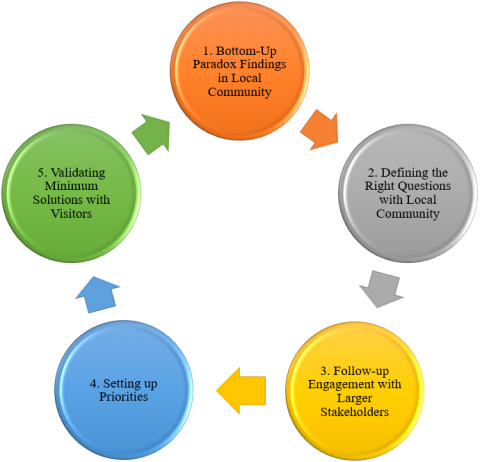
Figure 1. Sequential process to achieve sustainable tourism destination
The case study of Edelweiss Park demonstrates the successful implementation of these steps, showcasing how a village setting can achieve sustainable tourism development by incorporating environmental conservation, community engagement, and responsible tourism practices. This study aligns with the research conducted by Choi and Sirakaya [15] and Moscardo and Murphy [16], which emphasize the significance of prioritizing local residents in the planning and development of sustainable tourism policies. Furthermore, they stress that tourism should contribute to the overall well-being of the local communities.
By following this step-by-step approach mentioned in Figure 1, other destinations can learn from this model and work towards achieving their own sustainable tourism goals. This case study provides a response to the criticism surrounding the concept of sustainable tourism development and the suggested tools by previous researchers [3, 5].
This model illustrates a sequential process to achieve a sustainable tourism destination. It emphasizes the importance of balancing environmental preservation, engaging the local community, and collaborating with all stakeholders to create a destination that meets the needs of tourists while fostering sustainable development practices. This study reinforces previous research by Palacios-Florencio et al. [20] which advocated prioritizing environmental preservation, cultural conservation, and long-term economic benefits in decision-making processes.
In line with the research objective, the example of Edelweiss Park in Wonokitri village demonstrates the positive outcomes of empowering the local community in sustainable tourism. The park not only enhances tourist attractions but also creates memorable experiences for visitors, leading to increased satisfaction. Beyond economic gains, the local community reaps social benefits through cultural preservation and environmental conservation, which align with the goals of sustainable development. The collaborative efforts involving the government, private sector, and the engaged local community at Edelweiss Park exemplify how empowering the local community can foster tourism practices that yield comprehensive benefits for both the environment and the socio-economic well-being of the community.
This study is limited in scope as it exclusively examines sustainable practices in a single village. Consequently, there is a need for additional research encompassing a broader geographical area. Further investigations in different settings should apply the sequential process employed in this research to assess the model's validity.
Some actionable recommendations to implement sustainable tourism based on this case study include:
- Conduct Thorough Issue Analysis: Begin by conducting a comprehensive analysis of the challenges and concerns affecting the local community and the environment. This should involve rigorous research and data collection to understand the root causes of these issues.
- Engage a Multidisciplinary Stakeholder Group: Involve a diverse group of stakeholders, including community members, environmental experts, and tourism professionals. Collaborative efforts bring different perspectives and expertise to the table, ensuring a holistic understanding of the problems.
- Develop Viable Solutions: Once the issues are identified, work on formulating practical and sustainable solutions. These solutions should not only address the problems but also take into account the long-term well-being of the community and the environment.
- Transform Solutions into Tourist Attractions: Showcase the positive changes and sustainable practices through the development of tourist attractions. This might involve creating eco-friendly accommodations, cultural preservation projects, or conservation initiatives that become integral parts of the tourism experience.
- Promote Sustainable Tourism Practices: Implement marketing strategies that promote the destination as a hub for sustainable tourism. Emphasize the unique attractions and initiatives that highlight the commitment to sustainability.
- Measure and Communicate Impact: Continuously monitor and measure the impact of these sustainable practices on the community and the environment. Use this data to communicate the positive changes to both residents and visitors, reinforcing the destination's commitment to sustainability.
- Educate Tourists: Develop educational materials and programs for tourists to raise awareness about the destination's sustainable initiatives. Encourage responsible and sustainable travel practices among visitors.
- Evaluate and Adapt: Regularly assess the effectiveness of the implemented solutions and tourist attractions. Be open to adjustments and improvements based on feedback and changing circumstances.
By following these recommendations, destinations can effectively implement sustainable tourism practices that benefit the community, the environment, and attract responsible tourists. This approach transforms sustainable tourism from a theoretical concept into a practical and tangible reality that has positive impacts on all stakeholders involved.
[1] Kemenparekraf. (2023). Cerita Petualangan di Desa Wisata. https://www.indonesia.travel/desawisata/id/home. [2] Alonso-Muños, S., Torrejón-Ramos, M., Medina-Salgado, M.-S., González-Sánchez, R. (2023). Sustainability as a building block for tourism-future research: Tourism Agenda 2030. Tourism Review, 7(2): 461-474. https://doi.org/10.1108/TR-12-2021-0568 [3] Kawuryan, M.W., Fathani, A.T., Purnomo, E.P., Salsabila, L., Azmi, N.A., Setiawan, D., Fadhlurrohman, M.I. (2022). Sustainable tourism development in Indonesia: Bibliometric review and analysis. Indonesian Journal of Geography, 54(1): 154-166. http://doi.org/10.22146/ijg.64657 [4] Ramaano, A.I. (2021). Tourism policy and environmental impacts in Musina municipality: Lessons of a case study of failure. Tourism Critiques: Practice and Theory, 2(1): 91-114. https://doi.org/10.1108/TRC-12-2020-0021 [5] Liu, Z. (2003). Sustainable tourism development: A critique. Journal of Sustainable Tourism, 11(6): 459-475. https://doi.org/10.1080/09669580308667216 [6] Adnyani, N.S., Purnamawati, I.A. (2020). Tri Hita Karana and tourism village management models for wellbeing. Target: Jurnal Manajemen dan Bisnis, 2(2): 157-166. https://doi.org/10.30812/target.v2i2.750 [7] Purnomo, S., Rahayu, E.S., Riani, A.L., Suminah. (2019). Tourism village management based on information technology with destination management system. In 1st International Conference of Health, Science & Technology. Surakarta: LPPM Universitas Duta Bangsa Surakarta, Indonesia, 4(1): 229-233. https://doi.org/10.47701/icohetech.v1i1.809 [8] Nugraha, I.P., Rahmawati, P.I., Andayani, N.H. (2021). Serangan tourism village management strategy for achieving quality tourism destinations. In Advances in Economics, Business and Management Research, 197: 501-504. Denpasar: Atlantis Press. https://doi.org/10.2991/aebmr.k.211124.071 [9] Hardini, W., Karta, N.P., Suarthana, J.P. (2015). The study on Bali tourism village management towards four dimensions of experience economy. E-Journal of Tourism, 2(1): 49-54. http://doi.org/10.24922/eot.v2i1.19444 [10] Puriati, N.M., Darma, G.S. (2021). Menguji kesiapan pengelolaan desa wisata berbasis manajemen modern sebagai penggerak ekonomi rakyat. Bisma: Jurnal Manajemen, 7(2): 319-330. https://doi.org/10.23887/bjm.v7i2.34162 [11] Nagy, K.X., Segui, A. (2020). Experiences of community-based tourism in Romania: Chances and challenges. Journal of Tourism Analysis, 27(2): 143-163. https://doi.org/10.1108/JTA-08-2019-0033 [12] Risfandini, A., Sunardi, S. (2017). The application of sustainable development concept for tourism development in Indonesia. International Conferences SDGs 2030 Challenges and Solutions. Malang: Universitas Merdeka Malang, 1(1). [13] Sebele, L. (2010). Community-based tourism ventures, benefits and challenges: Khama rhino sanctuary trust, central district, Botswana. Tourism Management, 31(1): 136-146. https://doi.org/10.1016/j.tourman.2009.01.005 [14] Dodds, R., Ali, A., Galaski, K. (2016). Mobilizing knowledge: Determining key elements for success and pitfalls in developing community-based tourism. Current Issues in Tourism, 21(13): 1547-1568. https://doi.org/10.1080/13683500.2016.1150257 [15] Choi, H., Sirakaya, E. (2005). Measuring residents’ attitude toward sustainable tourism: Development of Sustainable Tourism Attitude Scale. Journal of Travel Research, 43(4): 380-394. https://doi.org/10.1177/0047287505274651 [16] Moscardo, G., Murphy, L. (2014). There is no such thing as sustainable tourism: Re-conceptualizing tourism as a tool for sustainability. Sustainability, 6(5): 2538-2561. https://doi.org/10.3390/su6052538 [17] Kişi, N. (2019). A strategic approach to sustainable tourism development using the A’Wot hybrid method: A case study of Zonguldak, Turkey. Sustainability, 11(4): 964. https://doi.org/10.3390/su11040964 [18] Hasyimi, V., Azizalrahman, H. (2021). Economy-led sustainable touristic city: The case of Surakarta, Indonesia. Journal of Tourism Futures. https://doi.org/10.1108/jtf-06-2020-0088 [19] Nowell, L.S., Norris, J.M., White, D.E. Moules, N.J. (2017). Thematic analysis: Striving to meet the trustworthiness criteria. International Journal of Qualitative Methods, 16: 1-13. https://doi.org/10.1177/1609406917733847 [20] Palacios-Florencio, B., Santos-Roldán, L., Berbel-Pineda, J. (2021). Sustainable tourism as a driving force of the tourism industry in a Post-COVID-19 scenario. Social Indicator Research, 158: 991-1011. https://doi.org/10.1007/s11205-021-02735-2
Phone: + 1 825 436 9306
Email: [email protected]
Subscription
Language support
Please sign up to receive notifications on new issues and newsletters from IIETA
Select Journal/Journals:
Copyright © 2024 IIETA. All Rights Reserved.
Community Empowerment and Sustainable Tourism Development: The Mediating Role of Community Support for Tourism
- TUIBS Leadership, Management & Human Resources
Research output : Contribution to journal › Article › peer-review
Access to Document
- 10.3390/su11226248
Fingerprint
- Power (Psychology) Engineering & Materials Science 100%
- empowerment Earth & Environmental Sciences 93%
- tourism development Earth & Environmental Sciences 87%
- Tourism Engineering & Materials Science 86%
- ecotourism Earth & Environmental Sciences 83%
- tourism Earth & Environmental Sciences 64%
- exchange theory Social Sciences 9%
- Pakistan Social Sciences 6%
T1 - Community Empowerment and Sustainable Tourism Development: The Mediating Role of Community Support for Tourism
AU - Khalid, Shahrukh
AU - Ahmad, Muhammad Shakil
AU - Ramayah, T.
AU - Hwang, Jinsoo
AU - Kim, Insin
PY - 2019/11/7
Y1 - 2019/11/7
N2 - Though community empowerment and sustainable tourism development (STD) have been discussed in the existing literature, little research has focused on the elaborate mechanisms between these two variables. Therefore, the present study examines the relationship between community empowerment and STD, along with the mediating role played by community support for tourism. Using social exchange theory, this research establishes theoretical relationships between vital variables for STD. A survey of empirical study was undertaken, and data were collected from 353 local residents in the northern area of Pakistan. The results for data analyses demonstrated a significant relationship between community empowerment and STD initiatives, and community support for tourism was shown to partially mediate the relationship between the two variables. The findings imply that high community empowerment enables the community to establish successful sustainable tourism development through local people’s support for tourism. This study contributes theoretically to identifying the idea that community members’ support for tourism has a crucial function bridging the link from community empowerment to sustain tourism in a local area.
AB - Though community empowerment and sustainable tourism development (STD) have been discussed in the existing literature, little research has focused on the elaborate mechanisms between these two variables. Therefore, the present study examines the relationship between community empowerment and STD, along with the mediating role played by community support for tourism. Using social exchange theory, this research establishes theoretical relationships between vital variables for STD. A survey of empirical study was undertaken, and data were collected from 353 local residents in the northern area of Pakistan. The results for data analyses demonstrated a significant relationship between community empowerment and STD initiatives, and community support for tourism was shown to partially mediate the relationship between the two variables. The findings imply that high community empowerment enables the community to establish successful sustainable tourism development through local people’s support for tourism. This study contributes theoretically to identifying the idea that community members’ support for tourism has a crucial function bridging the link from community empowerment to sustain tourism in a local area.
U2 - 10.3390/su11226248
DO - 10.3390/su11226248
M3 - Article
SN - 2071-1050
JO - Sustainability
JF - Sustainability
Tourism has become a source of income and a point of pride for the people of Jalapão in Tocantins, Brazil

"Golden grass lifted us from extreme poverty," says Railane Ribeiro da Silva
Mariana Ceratti/World Bank
A tiny community in central Brazil has made a name for itself in tourism and design, all thanks to a native plant known as golden grass, which is used to craft accessories and decorative items. This natural resource now stands for both the earnings and the pride of Mumbuca's quilombola community in Tocantins, particularly for the Village's Association of Artisans and Extractors, who greet global visitors with music and tales.
"My golden grass, my golden grass that sprouted in the field unplanted
It was my beloved who said to me that the field's flower is my golden grass
It was Grandma Miúda who showed us how to weave
Golden grass with great affection
It was in Mumbuca that this craft began with much love”
"When you buy golden grass, you're not just purchasing a product; you're preserving a tradition that's over two centuries old and still standing strong," explains 28-year-old artisan Railane Ribeiro da Silva. "Golden grass lifted us from extreme poverty, which used to make us fearful of outsiders. If tourists came by, the locals would scatter," she adds.
Railane is the granddaughter of Grandma Miúda (Guilhermina Ribeiro da Silva, 1928-2010), who learned the art of braiding golden grass from her mother, an indigenous descendant, and passed on the skill to other women. Grandma Miúda played a crucial role in popularizing this craft nationwide and bringing progress to the region.
The World Bank joined this narrative by funding the golden grass supply chain through the Integrated and Sustainable Regional Development Project of Tocantins (PDRIS), carried out over nine years in partnership with the state government. This initiative poured $282 million into seven sectors: transportation, education, agriculture, the environment, tourism, water resources, and public management enhancement.
In tourism alone, $3 million was allocated for various projects. In Mumbuca, the project helped establish a modest museum, the Memorial House of Culture, where visitors can delve into Grandma Miúda's history, view golden grass cultivation and harvesting photos, and admire crafted items. "We managed to get cabinets, a printer, GPS, a fully equipped office," Railane rejoices.
The project also enabled sustainable harvesting training, attracting a new wave of artisans. "The training sessions made it easier to develop products from golden grass," remembers Fatima Amazonas, who co-managed the project for five years. "The women needed a proper place to sell their goods, as the previous setup was quite makeshift. They gained empowerment through sheer determination and joy," she continues.

Meanwhile, in Prata Community in São Félix do Tocantins, the project funded a plaza that's now a central hub for locals. Just four decades ago, this quilombola community was cut off from the world.
"We had no transportation back then. Our lives were very basic," teacher Osirene Francisca de Souza reminisces. "Electricity didn't arrive until the 2000s," she adds.
Now, with solar panels and internet access, the plaza symbolizes progress for Osirene. "It's even become a venue for school events," she notes. On weekends, the plaza is a lively spot where adults can unwind at food stalls while kids play in the playground.
Other project-supported initiatives include:
• The establishment of the Tocantins Tourism Observatory in partnership with local educational and commerce institutes for sector research and planning
• The creation of an adventure park in Cantão State Park with zip lines and acrobatic paths
• The formulation of a strategic plan to enhance sport fishing in several municipalities
• The commissioning of a bird-watching guide for Tocantins and training for bird guides
• The installation of tourist signs in the Serras Gerais region.
The tourism boom necessitated visitor-friendly infrastructure. At Tri Agro Farm, the gateway to Cachoeira da Velha, new restrooms and a rest area kiosk were constructed. Similarly, a shelter kiosk was built at the entrance to Jalapão State Park, famed for its dunes.
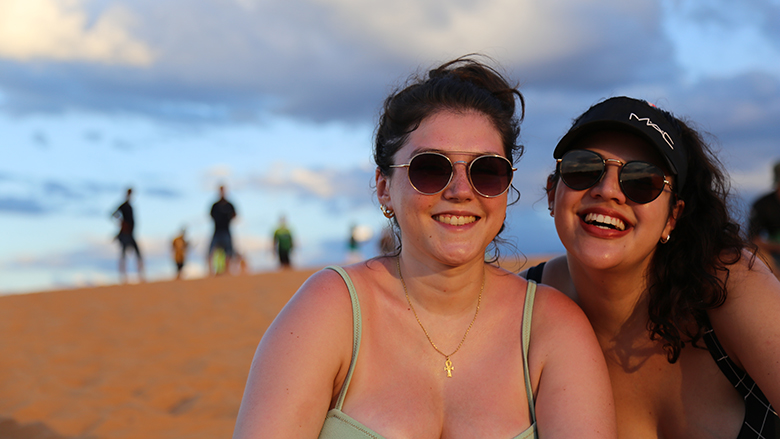
These enhancements have improved the visitor experience, as noted by 26-year-old advertiser Beatriz Fróes and 25-year-old food engineer Maria Julia Rossi from São Paulo. "The beauty, the cuisine, our guide, and the reasonable prices made our visit delightful," they commend. "Some services and signs could be better, but that's to be expected in an emerging tourist destination."
The charm and untouched nature of Jalapão also captivated Kàllyta Queiroz, 28, and Josias Rodrigues, 38, from Redenção in Pará. After a 500 km drive, they found the journey worthwhile. "We plan to bring our daughters when they're older," says Kàllyta, a mother of three. Traveling with young children is not advisable due to the lengthy dirt road drives.
For adults and youth alike, however, a trip to Jalapão promises an unforgettable blend of natural beauty, culture, and hospitality in a Brazilian region ripe for exploration.
This site uses cookies to optimize functionality and give you the best possible experience. If you continue to navigate this website beyond this page, cookies will be placed on your browser. To learn more about cookies, click here .
Estimating the recreational value of mountain tourism to shape sustainable development in Gilgit-Baltistan, Pakistan
Mountain tourism has been experiencing remarkable growth in Pakistan, and the economy of mountainous regions is increasingly reliant on the tourism sector. However, the vulnerability of mountain tourism to climate change and human activities poses severe threats to its long-term sustainability, and addressing these challenges necessitates meticulous planning and immediate policy attention to effectively mitigate potential risks and secure the future of mountain tourism. This study aims to aid in formulating policies that promote sustainable mountain tourism by estimating the recreational value associated with high mountain tourism in Hunza Valley. The total recreational value is considered an indicator of the economic viability of tourism in high mountain regions. Data were collected from 1046 tourists through on-site surveys conducted during 2021–2022, and the estimation model employed a truncated negative binomial regression technique. This study reveals that the annual recreational value per person for visiting the Hunza Valley amounts to USD 126.3, resulting in a total annual recreational value of USD 22.8 million of the region. These estimations provide valuable insights to policymakers, enabling them to understand the area's economic potential better and facilitate efficient resource allocation strategies within the mountainous landscape. Furthermore, these findings offer critical guidance for informed decision-making concerning natural resource management, ensuring the conservation and preservation of the region's unique landscapes and historical sites.
- Tourism policy;
- Ecological impacts;
- Sustainable tourism;
- High mountain regions Gilgit-Baltistan;
- Travel cost method
- Photo Gallery
- Privacy Policy
- Terms of Use

- Infographics
- Listen To CitiFM
- Watch Citi TV
Embracing Africapitalism: Path to sustainable development and economic empowerment [Article]
Africa stands at crossroads—a continent beaming with potential, innovation, and promise. As we navigate the complexities of the global landscape, it is important that we chart a course towards sustainable development, inclusive growth, and shared prosperity.
At the forefront of this transformative journey is the philosophy of Africapitalism—a bold and visionary approach to economic empowerment, driven by the belief that the private sector has a pivotal role to play in advancing Africa’s development agenda.
I am deeply committed to harnessing the power of strategic partnerships, innovative solutions, and inclusive policies to drive sustainable development across the continent. We are working to unlock Africa’s vast potential and empower its people to thrive and prosper.
At the forefront of this transformative journey are three critical themes that demand our urgent attention and collective action:
Entrepreneurship and Job Creation for Global Food Security:
The role of entrepreneurship in fostering global food security cannot be overstated. As we grapple with the challenges of food insecurity and hunger, entrepreneurship emerges as a powerful tool for innovation, resilience, and sustainable agricultural practices. Through initiatives like the Tony Elumelu Foundation (TEF), we remain committed to empowering African entrepreneurs to drive agricultural innovation, create jobs, and enhance food security across the continent.
Economic Empowerment of Africa’s Youth to Address Migration Challenges:
Africa’s youth represent a demographic dividend and a catalyst for economic growth and prosperity. By investing in the economic empowerment of Africa’s youth through entrepreneurship, skills development, and access to finance, we can unlock their potential as agents of change, address migration challenges, and create meaningful employment opportunities.
Private-Public Partnerships for Access to Healthcare and Innovation:
Access to quality healthcare is a fundamental human right and a cornerstone of sustainable development. Yet, millions of people around the world lack access to essential health services, medicines, and vaccines. Through private-public partnerships, we can democratize access to healthcare, foster innovation, and improve the quality of life globally. UBA Bank stands ready to collaborate with foundations to drive innovation in healthcare delivery, promote preventive healthcare measures, and build resilient health systems that leave no one behind.
As global leaders gather to attend the Health Leaders’ Forum in Abu Dhabi, the World Food Programme Roundtable Reception in London, and the G7 Forum in Rome, let us reaffirm our commitment to driving sustainable development, fostering entrepreneurship, and building resilient communities. Together, let us harness the power of entrepreneurship, economic empowerment, and private-public partnerships to create a more prosperous, equitable, and sustainable world for all.
By harnessing the potential of renewable energy, investing in clean technology, and fostering cross-sectoral collaboration, we can drive economic transformation, mitigate climate change, and build a more prosperous and resilient future for generations to come. As Africa’s leading financial institution, UBA Bank is at the forefront of mobilizing capital and expertise to support the transition to a low-carbon economy, ensuring that Africa remains a key player in the global energy landscape. It is imperative that we prioritize climate change action, as the effects of climate change are already being felt across the continent, from extreme weather events to shifts in agricultural patterns.
By investing in renewable energy infrastructure and promoting sustainable practices, we can mitigate the impacts of climate change and build a more sustainable future for Africa and the world.
African nations have received foreign developmental support since gaining independence, encompassing loans, grants, and technical partnerships aimed at fostering economic development and improving welfare across the continent. UBA continues to be the preferred banking partner for Embassies, Multilateral Organizations, Development Institutions, NGOs, and Foundations (EMDO), offering holistic solutions to address both global and local banking requirements throughout sub-Saharan Africa.
In conclusion, Africapitalism is not just a philosophy—it’s a call to action, a blueprint for transformative change, and a vision for a prosperous and equitable Africa. As a global leader and advocate for sustainable development, I am committed to driving Africa’s transformational agenda through strategic partnerships, innovative solutions, and inclusive growth. Together, let us build a future where every African has the opportunity to thrive and succeed.
Explore the world of impactful news with CitiNewsroom on WhatsApp!
Click on the link to join the Citi Newsroom channel for curated, meaningful stories tailored just for YOU: https://whatsapp.com/channel/0029VaCYzPRAYlUPudDDe53x
No spams, just the stories that truly matter! #StayInformed #CitiNewsroom #CNRDigital
Cecilia Dapaah saga: Domelevo questions EOCO’s inaction on money laundering allegations
Traffic returns to mallam-kasoa road following downpour, related posts.

Shortage of ‘bentua’ hits Accra Central Market


Corruption fight: All crooked deals are cooked at Jubilee House – Franklin Cudjoe

Bono East: Sammy Gyamfi presents 11 motorbikes to NDC regional communications bureau

Govt could only account for $42m out of GARID’s $200m loan – Kofi Adams
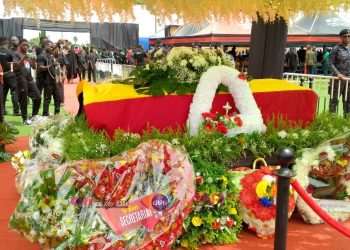
Late John Kumah laid to rest in solemn burial service [Photos]

Commuters unhappy with condition of alternative route to Accra from Kasoa Toll Booth

TOP STORIES

CitiNewsroom.com is Ghana's leading news website that delivers high quality innovative, alternative news that challenges the status quo.
Download App

© 2024 All Rights Reserved Citi Newsroom .
Privacy Overview

UN Tourism joins launch of Ireland’s first sustainable tourism observatory

UN Tourism has celebrated the official launch of the Atlantic Sustainable Tourism Observatory Ireland (ASTOI) in Sligo, Ireland.
The Observatory, which has been admitted into the International Network of Sustainable Tourism Observatories (INSTO) underscores Ireland’s commitment to fostering sustainable practices within its tourism industry. To mark the occasion, a delegation from UN Tourism met with the Minister for Tourism, Culture, Arts, Gaeltacht, Sport, and Media, Mrs. Catherine Martin to discuss the latest developments in tourism sustainability and resilience, and the importance of joining forces to meet jointly the planetary crisis.
ASTOI will collaborate closely with destinations along the Atlantic coast, on the islands and in the Heartlands region to monitor, evaluate, and promote sustainable tourism initiatives, ensuring environmental conservation, socio-economic development and cultural preservation. The observatory stands for a commitment to evidence- based decision making based on participatory approaches and transparency.
The Observatory will monitor, among other issues, 11 key areas that touch upon all three sustainability pillars, including climate change, water, wastewater and energy management, as well as local satisfaction and accessibility.

Related Articles
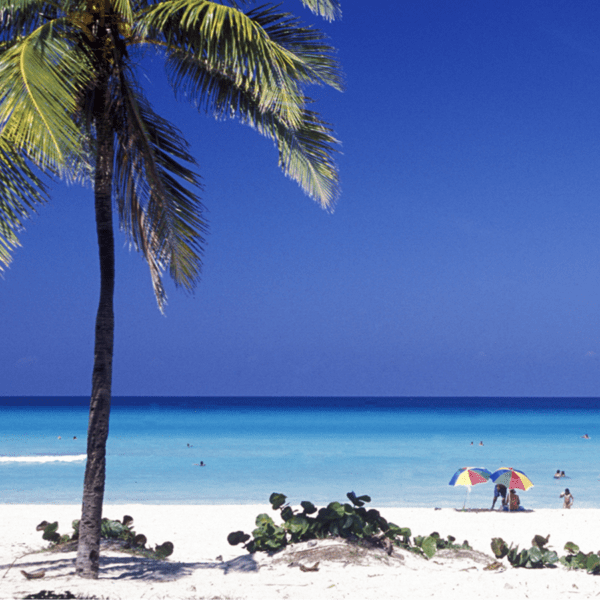
UN Tourism: Putting Communities at the Centre of Tourism Development in the Americas

UN Tourism and Hotelschool The Hague to drive innovation in hospitality

UN Tourism members advance agenda for Europe as region leads global recovery
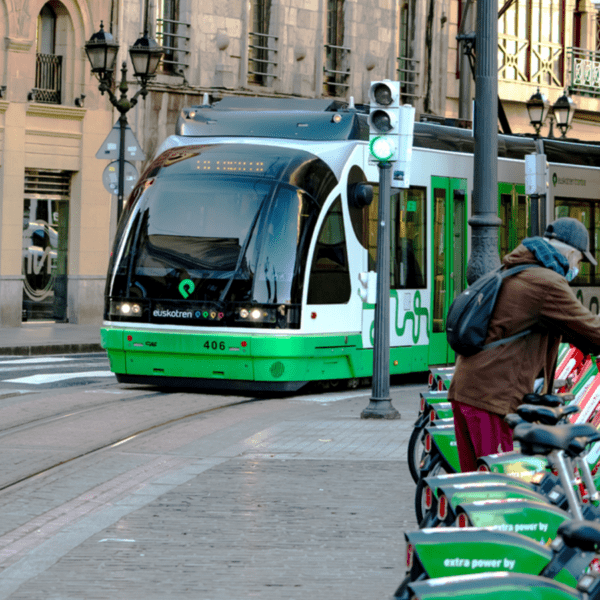
UN Tourism and UN Habitat partner for a better urban future through tourism
Related courses.
You might also like:

McDreams becomes first hotel group to roll 100% AI-powered guest enquiries system

Driving revenue growth through operational excellence

Sleep tourism now mainstream with the Global Sleep Symposium at the Equinox Hotel

From data to decisions: how tech tools help navigate hotel management challenges

Recipe for navigating the restaurant business opening

Join over 60,000 industry leaders.
Receive daily leadership insights and stay ahead of the competition.
Leading solution providers:
BPN Solutions

Away Together
Arch Amenities Group


Nurturing Uganda: Embracing responsible tourism for sustainable development
__________________
Embracing responsible tourism practices is crucial to ensure that tourism in Uganda contributes positively to the country’s sustainable development. This article explores the principles and practices of responsible tourism in Uganda.
Environmental conservation Protecting Uganda’s natural wonders, including its national parks, forests and waterways, is paramount. Responsible tourists minimise their environmental footprint by adhering to principles such as “Leave No Trace” and supporting eco-friendly accommodations and tour operators.
Engaging in wildlife viewing activities, such as gorilla trekking and safari tours, should be conducted with respect for wildlife and their habitats. Following guidelines provided by trained guides and park authorities helps minimise disturbance to animals and ecosystems.
Cultural preservation Uganda is home to a rich tapestry of cultures and traditions, from the diverse indigenous tribes to vibrant urban communities. Responsible tourists embrace cultural sensitivity and respect local beliefs and practices.
Participating in cultural experiences, such as traditional dances, storytelling sessions and community visits, should be done in a manner that honours and supports local communities. Travellers can contribute positively by purchasing locally made crafts, souvenirs and products directly from artisans and co-operatives.
Community Empowerment Responsible tourism aims to empower local communities by providing economic opportunities, fostering cultural pride and supporting social development initiatives. Travellers can choose accommodations, tours and activities that prioritise community engagement and benefit local residents.
Supporting community-based tourism enterprises, such as homestays, community-run lodges and guided tours led by local experts, ensure that tourism revenues directly benefit the communities hosting visitors.
Sustainable Practices Sustainable tourism practices, such as waste reduction, energy conservation and water management, play a crucial role in minimising the environmental impact of tourism operations. Responsible tourists support businesses and accommodations that implement sustainable practices.
Choosing eco-friendly transportation options, such as walking, cycling, or using public transportation, reduces carbon emissions and promotes sustainable mobility.
Education And Awareness Promoting awareness and understanding of responsible tourism principles among travellers, tour operators and local communities is essential for fostering a culture of sustainability.
Educational programmes, interpretive signage and interactive experiences can help visitors learn about the importance of conservation and responsible travel practices.
Engaging in responsible tourism requires ongoing learning and dialogue between stakeholders, including government agencies, non-profit organisations, businesses and local communities.
Embracing responsible tourism in Uganda is not only a matter of preserving natural and cultural heritage, but also a pathway to sustainable development and equitable growth.
By practising environmental stewardship, respecting cultural diversity, empowering local communities and promoting sustainable practices, tourists can contribute to Uganda’s journey towards a more resilient and prosperous future.
Together, we can nurture Uganda’s natural and cultural treasures for generations to come.
The writer is the executive director of Uganda Tourism Board
UN Tourism | Bringing the world closer
Share this content.
- Share this article on facebook
- Share this article on twitter
- Share this article on linkedin
Webinar by UN Tourism and Amadeus: Travel Insights 2024: Focus on the Americas
Enabling destinations to better understand travel insights for their region | May 14th, 2024 | Zoom English Session: 4:00 - 4:45 pm (CEST) | Spanish Session: 5:00 - 5:45 pm (CEST)
Tuesday, May 14th, 2024. As travel experiences a remarkable resurgence, the global hospitality industry prepares for a new era of exploration. In an effort to equip destinations with practical insights, UN Tourism and its Affiliate Member, Amadeus, are joining forces to introduce a groundbreaking webinar titled "Travel Insights 2024: Focus on the Americas".
Scheduled for May 14th, in two sessions, one in English and the other in Spanish, these webinars aim to equip stakeholders with comprehensive Market Intelligence. Attendees will gain invaluable insights into emerging trends, booking patterns, and the evolving expectations of travellers.
UN Tourism and Amadeus share a common objective: to assist global hospitality organizations by providing the essential insights necessary to stimulate travel demand, all while prioritizing sustainability to safeguard our planet, its destinations, and its inhabitants.
Attendees can look forward to an interactive session, offering a platform to delve deeper into key insights and address pressing concerns.
English Session: 4:00 - 4:45 pm (CEST)
Spanish Session: 5:00 - 5:45 pm (CEST)
Don't miss this opportunity to gain a deeper understanding of travel dynamics in the Americas and discover strategies to thrive in a post-pandemic world.
Welcome by Ms. Sandra Carvao, UN Tourism
Welcome by Mr. Gustavo Santos, UN Tourism
Presentation by Mr. Javier Ruescas, UN Tourism
Presentation by Ms. Caterina Pintus, Destination Intelligence Director, Amadeus
Q&A session
Presentation by Mr. Michel Julian, UN Tourism
Presentation by Mr. Franz Müller, Latin America & Caribbean Regional Sales Manager, Amadeus
Presentations:
- Focus on the Americas: Unveiling regional travel trends
- Enfoque en las Américas: Tendencias regionales de viajes
- World Tourism Barometer | Volume 22 · Issue 1 · January 2024 (v.3)
Related links
- Amadeus & UN Tourism joint report reveals tourism in the Americas is on the rise
Related Content
69th meeting of un tourism regional commission for the ..., 68th meeting of the unwto regional commission for the a..., workshop on tourism statistics with a focus on the caribbean, executive council - 118th session.

IMAGES
VIDEO
COMMENTS
Though community empowerment and sustainable tourism development (STD) have been discussed in the existing literature, little research has focused on the elaborate mechanisms between these two variables. Therefore, the present study examines the relationship between community empowerment and STD, along with the mediating role played by community support for tourism. Using social exchange ...
An important component of sustainable tourism development, empowerment is seen as a multilayered, interdependent phenomenon that affects people on a personal, organizational, and communal level (Sharma et al., 2022). ... To achieve sustainable tourism development, present research suggests that local inhabitants' involvement in tourism related ...
This means that women's empowerment plays a leading role in the accomplishment of sustainable tourism development. These results are consistent with the study of Boley and McGehee (2014), which showed that empowering women would facilitate the achievement of sustainable tourism development goals.
Sustainable development of tourism symbolizes a type of business activity that satisfies the requirements of both the tourists and the receiving communities. The paper aims to unearth the impact of community empowerment on the sustainable tourism development. ... Further, local support is incorporated as a mediating variable between the ...
Women's empowerment and tourism. Tourism has a pivotal role to play in achieving the objectives at the heart of the 2030 Agenda for Sustainable Development, in particular the commitments to gender equality and the empowerment of women of Sustainable Development Goal 5. As a specialised UN agency in the field of tourism, UN Tourism is committed ...
Institute of Development Studies, Massey University, Palmerston North 4410, New Zealand; h.vanderwatt@massey .ac.nz. * Correspondence: [email protected]; Tel.: +64-63505799. Abstract: For ...
For over twenty years, tourism researchers have examined how to determine whether destination communities are being empowered through tourism: there is much we can learn through analysis of that work. We outline and critique the most commonly used empowerment framework in this field as was first published by Scheyvens in 1999, which has four dimensions (psychological, social, economic and ...
A joint effort by UNWTO, UNDP and other partners, Tourism and the Sustainable Development Goals - Journey to 2030 aims to build knowledge, and empower and inspire tourism stakeholders to take necessary action to accelerate the shift towards a more sustainable tourism sector by aligning policies, business operations and investments with the SDGs.
Introduction. Community participation is the key issue for tourism development of heritage sites and is a process that is vital to enhance long-term sustainable heritage management (Landorf, 2009).The participation of local residents in heritage sites improves residents' sense of belonging, facilitates the development of social networks, makes a positive contribution to the quality of life ...
Summary. Sustainable development is the foundational principle for enhancing human and economic development while maintaining the functional integrity of ecological and social systems that support regional economies. Tourism has played a critical role in sustainable development in many countries and regions around the world.
Community-based tourism (CBT) has become a popular segment of sustainable tourism development worldwide to provide community welfare and empowerment. CBT has been pushed as one of the strategies for poverty alleviation, particularly in marginalized regions and communities. Thus, tourism has also experienced negative impacts creating a ...
Introduction. Tourism and development: theories and relationships. What is empowerment? Tourism development in the South Pacific. International cooperation or disguised dependency? The South Pacific region. Empowerment at the national level. Empowerment and disempowerment at the village level. Empowerment and sustainability through village ownership. Sustainability through empowerment and an ...
Aiming to explore theoretical advances in tourism studies, this book explores the triadic relationship between tourism, sustainable development and empowerment. While tourism has begun to focus on community consultations, the process has tended to follow the path of development for communities rather than development by communities. In many cases the result has been disempowerment rather than ...
4.1 Local community empowerment and sustainable tourism development. In recent years, efforts have been made to cultivate Edelweiss flowers to meet demand while protecting wild populations. Cultivation techniques have been developed to grow Edelweiss in controlled environments or gardens, ensuring a sustainable supply of the flower while ...
Abstract. Though community empowerment and sustainable tourism development (STD) have been discussed in the existing literature, little research has focused on the elaborate mechanisms between these two variables. Therefore, the present study examines the relationship between community empowerment and STD, along with the mediating role played ...
The findings imply that high community empowerment enables the community to establish successful sustainable tourism development through local people's support for tourism. This study contributes theoretically to identifying the idea that community members' support for tourism has a crucial function bridging the link from community ...
Knowledge, empowerment, and action: testing the empowerment theory in a tourism context. Abstract With resident empowerment widely recognized as a prerequisite for sustainable tourism development, this study tested how residents' perceived knowledge of tourism affects their perceptions….
Though community empowerment and sustainable tourism development (STD) have been discussed in the existing literature, little research has focused on the elaborate mechanisms between these two ...
Sustainable tourism development requires the informed participation of all relevant stakeholders, as well as strong political leadership to ensure wide participation and consensus building. Achieving sustainable tourism is a continuous process and it requires constant monitoring of impacts, introducing the necessary preventive and/or corrective ...
Empowerment of the community will become a main key for tourism development because with empowerment and involvement of the community in tourism development, the community where the tourism is developed will participate in keeping their culture and nature so that at the end the sustainable tourism development will be reached and maintain. Â ...
Nevertheless, the empowerment lens provides a useful framework for examining relationships of actors within the CBT as a sustainable form of tourism development and social change (Lardier, Citation 2018; Zimmerman et al., Citation 2018). The need exists to incorporate empowerment praxis in a way that increasingly accommodates emic insights.
Abstract: The emergence of "community-based tourism" (CBT) is seen as a viable and alternative means of. promoting sustainable tourism development, enhancing community welfare, as well as ...
Tourism has become a source of income and a point of pride for the people of Jalapão in Tocantins, Brazil ... The World Bank joined this narrative by funding the golden grass supply chain through the Integrated and Sustainable Regional Development Project of Tocantins (PDRIS), carried out over nine years in partnership with the state ...
Mountain tourism has been experiencing remarkable growth in Pakistan, and the economy of mountainous regions is increasingly reliant on the tourism sector. However, the vulnerability of mountain tourism to climate change and human activities poses severe threats to its long-term sustainability, and addressing these challenges necessitates meticulous planning and immediate policy attention to ...
At the forefront of this transformative journey is the philosophy of Africapitalism—a bold and visionary approach to economic empowerment, driven by the belief that the private sector has a pivotal role to play in advancing Africa's development agenda. I am deeply committed to harnessing the power of strategic partnerships, innovative ...
UN Tourism has celebrated the official launch of the Atlantic Sustainable Tourism Observatory Ireland (ASTOI) in Sligo, Ireland. The Observatory, which has been admitted into the International Network of Sustainable Tourism Observatories (INSTO) underscores Ireland's commitment to fostering sustainable practices within its tourism industry.
ABSTRACT Sustainable development of tourism symbolizes a type of business activity that satisfies the requirements of both the tourists and the receiving communities. The paper aims to unearth the impact of community empowerment on the sustainable tourism development. Further, local support is incorporated as a mediating variable between the relationship of community empowerment and ...
Community Empowerment Responsible tourism aims to empower local communities by providing economic opportunities, fostering cultural pride and supporting social development initiatives. Travellers ...
Tuesday, May 14th, 2024. As travel experiences a remarkable resurgence, the global hospitality industry prepares for a new era of exploration. In an effort to equip destinations with practical insights, UN Tourism and its Affiliate Member, Amadeus, are joining forces to introduce a groundbreaking webinar titled "Travel Insights 2024: Focus on ...